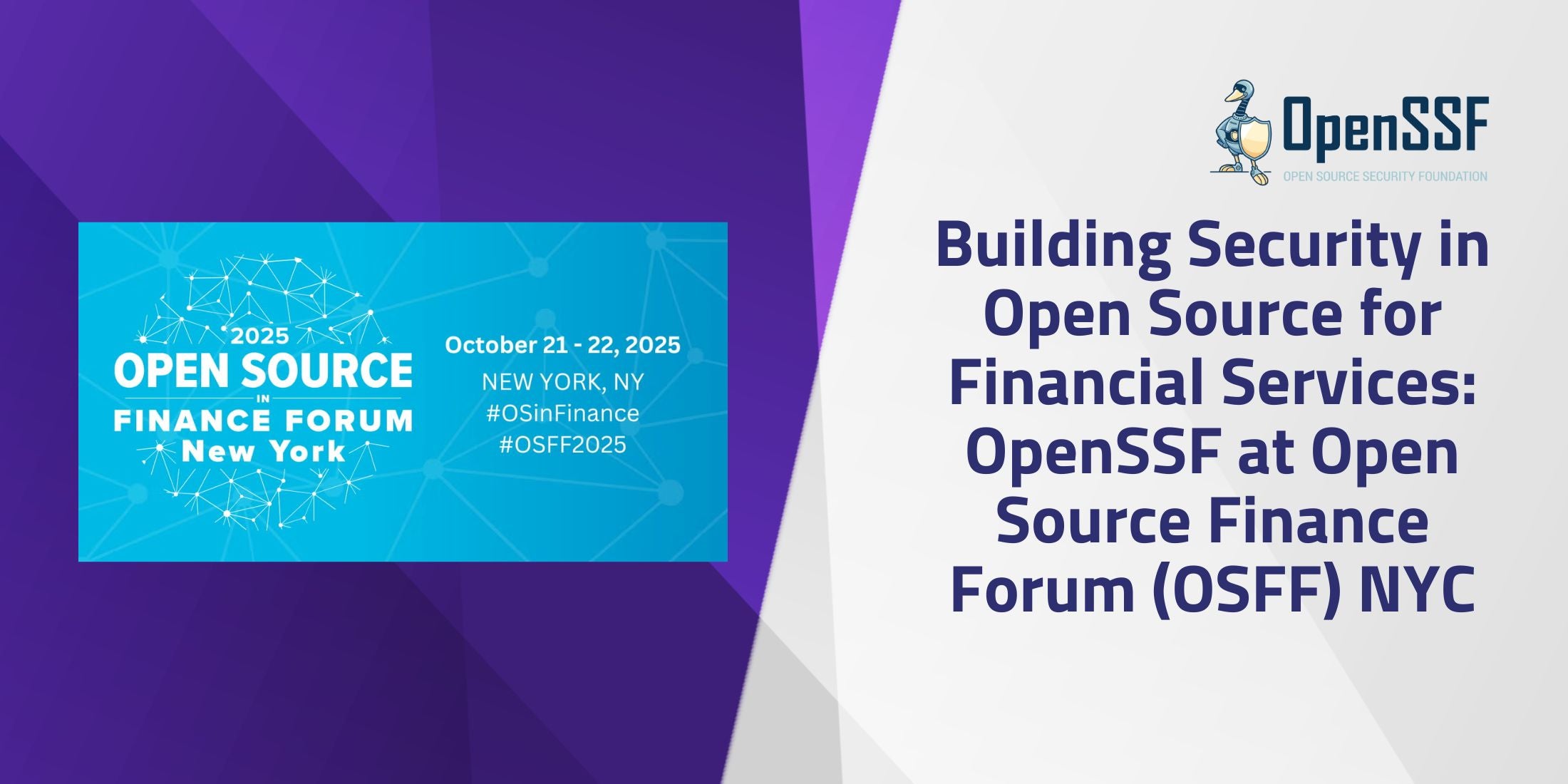


In this episode of What’s in the SOSS, CRob sits down with John Amaral from Root.io to explore the evolving landscape of open source security and vulnerability management. They discuss how AI and LLM technologies are revolutionizing the way we approach security challenges, from the shift away from traditional “scan and triage” methodologies to an emerging “fix first” approach powered by agentic systems. John shares insights on the democratization of coding through AI tools, the unique security challenges of containerized environments versus traditional VMs, and how modern developers can leverage AI as a “pair programmer” and security analyst. The conversation covers the transition from “shift left” to “shift out” security practices and offers practical advice for open source maintainers looking to enhance their security posture using AI tools.
00:25 – Welcome and introductions
01:05 – John’s open source journey and Root.io’s SIM Toolkit project
02:24 – How application development has evolved over 20 years
05:44 – The shift from engineering rigor to accessible coding with AI
08:29 – Balancing AI acceleration with security responsibilities
10:08 – Traditional vs. containerized vulnerability management approaches
13:18 – Leveraging AI and ML for modern vulnerability management
16:58 – The coming “remediation revolution” and fix-first approach
18:24 – Why “shift left” security isn’t working for developers
19:35 – Using AI as a cybernetic programming and analysis partner
20:02 – Call to action: Start using AI tools for security today
22:00 – Closing thoughts and wrap-up
Intro Music & Promotional clip (00:00)
CRob (00:25)
Welcome, welcome, welcome to What’s in the SOSS, the OpenSSF’s podcast where I talk to upstream maintainers, industry professionals, educators, academics, and researchers all about the amazing world of upstream open source security and software supply chain security.
Today, we have a real treat. We have John from Root.io with us here, and we’re going to be talking a little bit about some of the new air quotes, “cutting edge” things going on in the space of containers and AI security. But before we jump into it, John, could maybe you share a little bit with the audience, like how you got into open source and what you’re doing upstream?
John (01:05)
First of all, great to be here. Thank you so much for taking the time at Black Hat to have a conversation. I really appreciate it. Open source, really great topic. I love it. Been doing stuff with open source for quite some time. How do I get into it? I’m a builder. I make things. I make software been writing software. Folks can’t see me, but you know, I’m gray and have no hair and all that sort of We’ve been doing this a while. And I think that it’s been a great journey and a pleasure in my life to work with software in a way that democratizes it, gets it out there. I’ve taken a special interest in security for a long time, 20 years of working in cybersecurity. It’s a problem that’s been near and dear to me since the first day I ever had my like first floppy disk, corrupted. I’ve been on a mission to fix that. And my open source journey has been diverse. My company, Root.io, we are the maintainers of an open source project called Slim SIM (or SUM) Toolkit, which is a pretty popular open source project that is about security and containers. And it’s been our goal, myself personally, and as in my latest company to really try to help make open source secure for the masses.
CRob (02:24)
Excellent. That is an excellent kind of vision and direction to take things. So from your perspective, I feel we’re very similar age and kind of came up maybe in semi-related paths. But from your perspective, how have you seen application development kind of transmogrify over the last 20 or so years? What has gotten better? What might’ve gotten a little worse?
John (02:51)
20 years, big time frame talking about modern open source software. I remember when Linux first came out. And I was playing with it. I actually ported it to a single board computer as one of my jobs as an engineer back in the day, which was super fun. Of course, we’ve seen what happened by making software available to folks. It’s become the foundation of everything.
Andreessen said software will eat the world while the teeth were open source. They really made software available and now 95 or more percent of everything we touch and do is open source software. I’ll add that in the grand scheme of things, it’s been tremendously secure, especially projects like Linux. We’re really splitting hairs, but security problems are real. as we’ve seen, proliferation of open source and proliferation of repos with things like GitHub and all that. Then today, proliferation of tooling and the ability to build software and then to build software with AI is just simply exponentiating the rate at which we can do things. Good people who build software for the right reasons can do things. Bad people who do things for the bad reasons can do things. And it’s an arms race.
And I think it’s really both benefiting software development, society, software builders with these tremendously powerful tools to do things that they want. A person in my career arc, today I feel like I have the power to write code at a rate that’s probably better than I ever have. I’ve always been hands on the keyboard, but I feel rejuvenated. I’ve become a business person in my life and built companies.
And I didn’t always have the time or maybe even the moment to do coding at the level I’d like. And today I’m banging out projects like I was 25 or even better. But at the same time that we’re getting all this leverage universally, we also noticed that there’s an impending kind of security risk where, yeah, we can find vulnerabilities and generate them faster than ever. And LLMs aren’t quite good yet at secure coding. I think they will be. But also attackers are using it for exploits and really as soon as a disclosed vulnerability comes out or even minutes later, they’re writing exploits that can target those. I love the fact that the pace and the leverage is high and I think the world’s going to do great things with it, the world of open source folks like us. At the same time, we’ve got to be more diligent and even better at defending.
CRob (05:44)
Right. I heard an interesting statement yesterday where folks were talking about software engineering as a discipline that’s maybe 40 to 60 years old. And engineering was kind of the core noun there. Where these people, these engineers were trained, they had a certain rigor. They might not have always enjoyed security, but they were engineers and there was a certain kind of elegance to the code and that was people much like artists where they took a lot of pride in their work and how the code you could understand what the code is. Today and especially in the last several years with the influx of AI tools especially that it’s a blessing and a curse that anybody can be a developer. Not just people that don’t have time that used to do it and now they get to of scratch that itch. But now anyone can write code and they may not necessarily have that same rigor and discipline that comes from like most of them engineering trades.
John (06:42)
I’m going to guess. I think it’s not walking out too far on limb that you probably coded in systems at some point in your life where you had a very small amount of memory to work with. You knew every line of code in the system. Like literally it was written. There might have been a shim operating system or something small, but I wrote embedded systems early in my career and we knew everything. We knew every line of code and the elegance and the and the efficiency of it and the speed of it. And we were very close to the CPU, very close to the hardware. It was slow building things because you had to handcraft everything, but it was very curated and very beautiful, so to speak. I find beauty in those things. You’re exactly right. I think I started to see this happen around the time when JVM started happening, Java Virtual Machines, where you didn’t have to worry about Java garbage collection. You didn’t have to worry about memory management.
And then progressively, levels of abstraction have changed right to to make coding faster and easier and I give it more you know more power and that’s great and we’ve built a lot more systems bigger systems open source helps. But now literally anyone who can speak cogently and describe what they want and get a system and. And I look at the code my LLM’s produce. I know what good code looks like. Our team is really good at engineering right?
Hmm, how did it think to do it that way? Then go back and we tell it what we want and you can massage it with some words. It’s really dangerous and if you don’t know how to look for security problems, that’s even more dangerous. Exactly, the level of abstraction is so high that people aren’t really curating code the way they might need to to build secure production grade systems.
CRob (08:29)
Especially if you are creating software with the intention of somebody else using it, probably in a business, then you’re not really thinking about all the extra steps you need to take to help protect yourself in your downstream.
John (08:44)
Yeah, yeah. think it’s an evolution, right? And where I think of it like these AI systems we’re working with are maybe second graders. When it comes to professional code authoring, they can produce a lot of good stuff, right? It’s really up to the user to discern what’s usable.
And we can get to prototypes very quickly, which I think is greatly powerful, which lets us iterate and develop. In my company, we use AI coding techniques for everything, but nothing gets into production, into customer hands that isn’t highly vetted and highly reviewed. So, the creation part goes much faster. The review part is still a human.
CRob (09:33)
Well, that’s good. Human on the loop is important.
John (09:35)
It is.
CRob (09:36)
So let’s change the topic slightly. Let’s talk a little bit more about vulnerability management. From your perspective, thinking about traditional brick and mortar organizations, how have you seen, what key differences do you see from someone that is more data center, server, VM focused versus the new generation of cloud native where we have containers and cloud?
What are some of the differences you see in managing your security profile and your vulnerabilities there?
John (10:08)
Yeah, so I’ll start out by a general statement about vulnerability management. In general, the way I observe current methodologies today are pretty traditional.
It’s scan, it’s inventory – What do I have for software? Let’s just focus on software. What do I have? Do I know what it is or not? Do I have a full inventory of it? Then you scan it and you get a laundry list of vulnerabilities, some false positives, false negatives that you’re able to find. And then I’ve got this long list and the typical pattern there is now triage, which are more important than others and which can I explain away. And then there’s a cycle of remediation, hopefully, a lot of times not, that you’re cycling work back to the engineering organization or to whoever is in charge of doing the remediation. And this is a very big loop, mostly starting with and ending with still long lists of vulnerabilities that need to be addressed and risk managed, right? It doesn’t really matter if you’re doing VMs or traditional software or containerized software. That’s the status quo, I would say, for the average company doing vulnerability maintenance. And vulnerability management, the remediation part of that ends up being some fractional work, meaning you just don’t have time to get to it all mostly, and it becomes a big tax on the development team to fix it. Because in software, it’s very difficult for DevSec teams to fix it when it’s actually a coding problem in the end.
In traditional VM world, I’d say that the potential impact and the velocity at which those move compared to containerized environments, where you have
Kubernetes and other kinds of orchestration systems that can literally proliferate containers everywhere in a place where infrastructure as code is the norm. I just say that the risk surface in these containerized environments is much more vast and oftentimes less understood. Whereas traditional VMs still follow a pattern of pretty prescriptive way of deployment. So I think in the end, the more prolific you can be with deploying code, the more likely you’ll have this massive risk surface and containers are so portable and easy to produce that they’re everywhere. You can pull them down from Docker Hub and these things are full of vulnerabilities and they’re sitting on people’s desks.
They’re sitting in staging areas or sitting in production. So proliferation is vast. And I think that in conjunction with really high vulnerability reporting rates, really high code production rates, vast consumption of open source, and then exploits at AI speed, we’re seeing this kind of almost explosive moment in risk from vulnerability management.
CRob (13:18)
So there’s been, over the last several, like machine intelligence, which has now transformed into artificial intelligence. It’s been around for several decades, but it seems like most recently, the last four years, two years, it has been exponentially accelerating. We have this whole spectrum of things, AI, ML, LLM, GenAI, now we have Agentic and MCP servers.
So kind of looking at all these different technologies, what recommendations do you have for organizations that are looking to try to manage their vulnerabilities and potentially leveraging some of this new intelligence, these new capabilities?
John (13:58)
Yeah, it’s amazing at the rate of change of these kinds of things.
CRob (14:02)
It’s crazy.
John (14:03)
I think there’s a massively accelerating, kind of exponentially accelerating feedback loop because once you have LLMs that can do work, they can help you evolve the systems that they manifest faster and faster and faster. It’s a flywheel effect. And that is where we’re going to get all this leverage in LLMs. At Root, we build an agentic platform that does vulnerability patching at scale. We’re trying to achieve sort of an open source scale level of that.
And I only said that because I believe that rapidly, not just us, but from an industry perspective, we’re evolving to have the capabilities through agentic systems based on modern LLMs to be able to really understand and modify code at scale. There’s a lot of investment going in by all the major players, whether it’s Google or Anthropic or OpenAI to make these LLM systems really good at understanding and generating code. At the heart of most vulnerabilities today, it’s a coding problem. You have vulnerable code.
And so, we’ve been able to exploit the coding capabilities to turn it into an expert security engineer and maintainer of any software system. And so I think what we’re on the verge of is this, I’ll call it remediation revolution. I mentioned that the status quo is typically inventory, scan, list, triage, do your best. That’s a scan for us kind of, you know, I’ll call it, it’s a mode where mostly you’re just trying to get a comprehensive list of the vulnerabilities you have. It’s going to get flipped on its head with this kind of technique where it’s going to be just fix everything first. And there’ll be outliers. There’ll be things that are kind of technically impossible to fix for a while. For instance, it could be a disclosure, but you really don’t know how it works. You don’t have CWEs. You don’t have all the things yet. So you can’t really know yet.
That gap will close very quickly once you know what code base it’s in and you understand it maybe through a POC or something like that. But I think we’re gonna enter into the remediation revolution of vulnerability management where at least for third party open source code, most of it will be fixed – a priority.
Now, zero days will start to happen faster, there’ll be all the things and there’ll be a long tail on this and certainly probably things we can’t even imagine yet. But generally, I think vulnerability management as we know it will enter into this phase of fix first. And I think that’s really exciting because in the end it creates a lot of work for teams to manage those lists, to deal with the re-engineering cycle. It’s basically latent rework that you have to do. You don’t really know what’s coming. And I think that can go away, which is exciting because it frees up security practitioners and engineers to focus on, I’d say more meaningful problems, less toil problems. And that’s good for software.
CRob (17:08)
It’s good for the security engineers.
John (17:09)
Correct.
CRob (17:10)
It’s good for the developers.
John (17:11)
It’s really good for developers. I think generally the shift left revolution in software really didn’t work the way people thought. Shifting that work left, it has two major frictions. One is it’s shifting new work to the engineering teams who are already maximally busy.
CRob (17:29)
Correct.
John (17:29)
I didn’t have time to do a lot of other things when I was an engineer. And the second is software engineers aren’t security engineers. They really don’t like the work and maybe aren’t good at the work. And so what we really want is to not have that work land on their plate. I think we’re entering into an age where, and this is a general statement for software, where software as a service and the idea of shift left is really going to be replaced with I call shift out, which is if you can have an agentic system do the work for you, especially if it’s work that is toilsome and difficult, low value, or even just security maintenance, right? Like lot of this work is hard. It’s hard. That patching things is hard, especially for the engineer who doesn’t know the code. If you can make that work go away and make it secure and agents can do that for you, I think there’s higher value work for engineers to be doing.
CRob (18:24)
Well, and especially with the trend with open source, kind of where people are assembling composing apps instead of creating them whole cloth. It’s a very rare engineer indeed that’s going to understand every piece of code that’s in there.
John (18:37)
And they don’t. I don’t think it’s feasible. don’t know one except the folks who write node for instance, Node works internally. They don’t know. And if there’s a vulnerability down there, some of that stuff’s really esoteric. You have to know how that code works to fix it. As I said, luckily, agent existing LLM systems with agents kind of powering them or using or exploiting them are really good at understanding big code bases. They have like almost a perfect memory for how the code fits together. Humans don’t, and it takes a long time to learn this code.
CRob (19:11)
Yeah, absolutely. And I’ve been using leveraging AI in my practice is there are certain specific tasks AI does very well. It’s great at analyzing large pools of data and providing you lists and kind of pointers and hints. Not so great making it up by its own, but generally it’s the expert system. It’s nice to have a buddy there to assist you.
John (19:35)
It’s a pair programmer for me, and it’s a pair of data analysts for you, and that’s how you use it. I think that’s a perfect. We effectively have become cybernetic organisms. Our organic capabilities augmented with this really powerful tool. I think it’s going to keep getting more and more excellent at the tasks that we need offloaded.
CRob (19:54)
That’s great. As we’re wrapping up here, do you have any closing thoughts or a call to action for the audience?
John (20:02)
Call to action for the audience – I think it’s again, passion play for me, vulnerability management, security of open source. A couple of things. same. Again, same cloth – I think again, we’re entering an age where think security, vulnerability management can be disrupted. I think anyone who’s struggling with kind of high effort work and that never ending list helps on the way techniques you can do with open source projects and that can get you started. Just for instance, researching vulnerabilities. If you’re not using LLMs for that, you should start tomorrow. It is an amazing buddy for digging in and understanding how things work and what these exploits are and what these risks are. There are tooling like mine and others out there that you can use to really take a lot of effort away from vulnerability management. I’d say that for any open source maintainers out there, I think you can start using these programming tools as pair programmers and security analysts for you. And they’re pretty good. And if you just learn some prompting techniques, you can probably secure your code at a level that you hadn’t before. It’s pretty good at figuring out where your security weaknesses are and telling you what to do about them. I think just these things can probably enhance security open source tremendously.
CRob (24:40)
That would be amazing to help kind of offload some of that burden from our maintainers and let them work on that excellent…
John (21:46)
Threat modeling, for instance, they’re actually pretty good at it. Yeah. Which is amazing. So start using the tools and make them your friend. And even if you don’t want to use them as a pair of programmer, certainly use them as a adjunct SecOps engineer.
CRob (22:00)
Well, excellent. John from Root.io. I really appreciate you coming in here, sharing your vision and your wisdom with the audience. Thanks for showing up.
John (22:10)
Pleasure was mine. Thank you so much for having me.
CRob (22:12)
And thank you everybody. That is a wrap. Happy open sourcing everybody. We’ll talk to you soon.
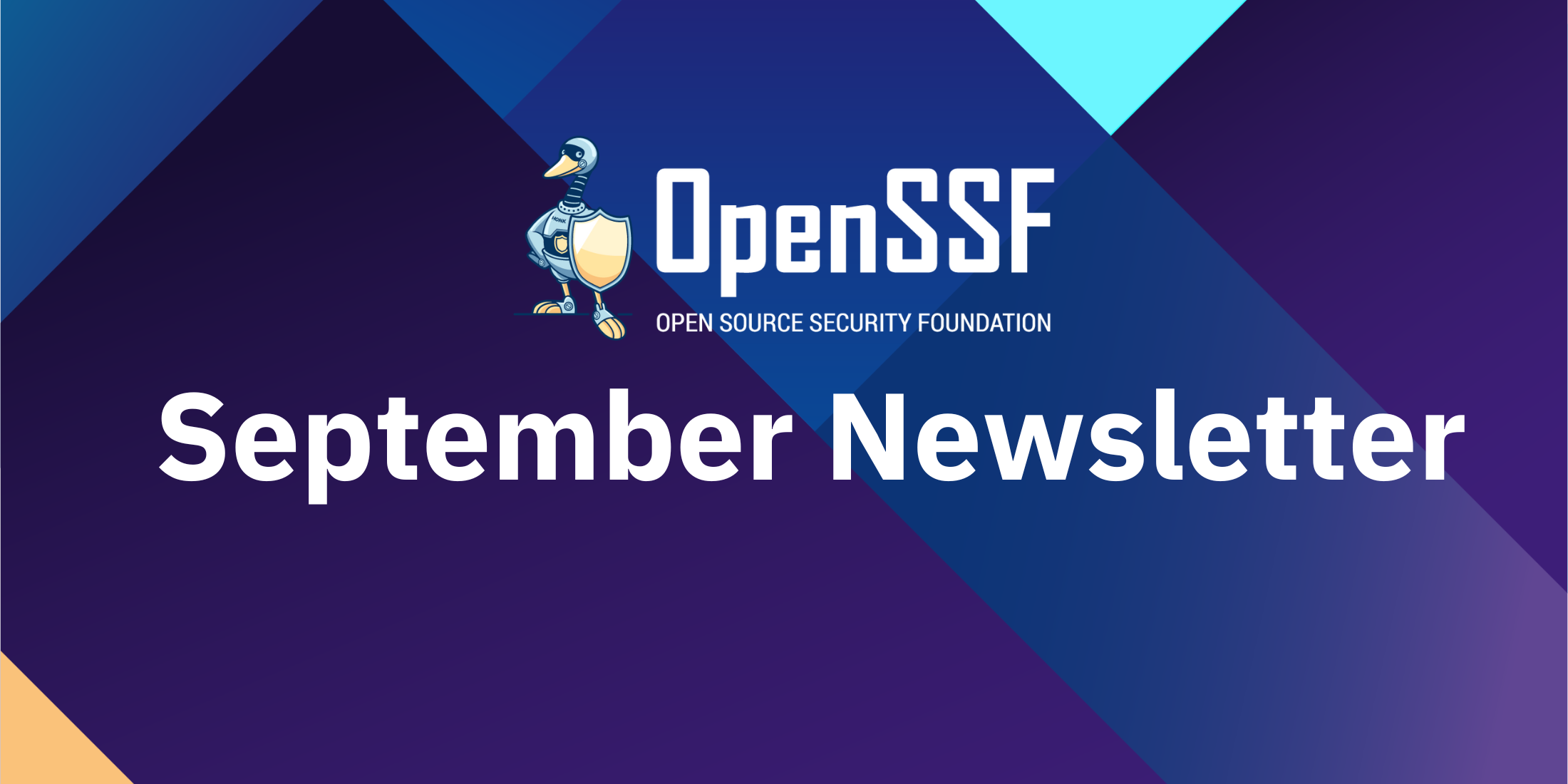
Welcome to the September 2025 edition of the OpenSSF Newsletter! Here’s a roundup of the latest developments, key events, and upcoming opportunities in the Open Source Security community.
🎉 Big week in Amsterdam: Recap of OpenSSF at OSSummit + OpenSSF Community Day Europe.
🥚 Golden Egg Awards shine on five amazing community leaders.
✨ Fresh resources: AI Code Assistant tips and SBOM whitepaper.
🤝 Trustify + GUAC = stronger supply chain security.
🌍 OpenSSF Community Day India: 230+ open source enthusiasts packed the room.
🎙 New podcasts: AI/ML security + post-quantum race.
🎓 Free courses to level up your security skills.
📅 Mark your calendar and join us for Community Events.
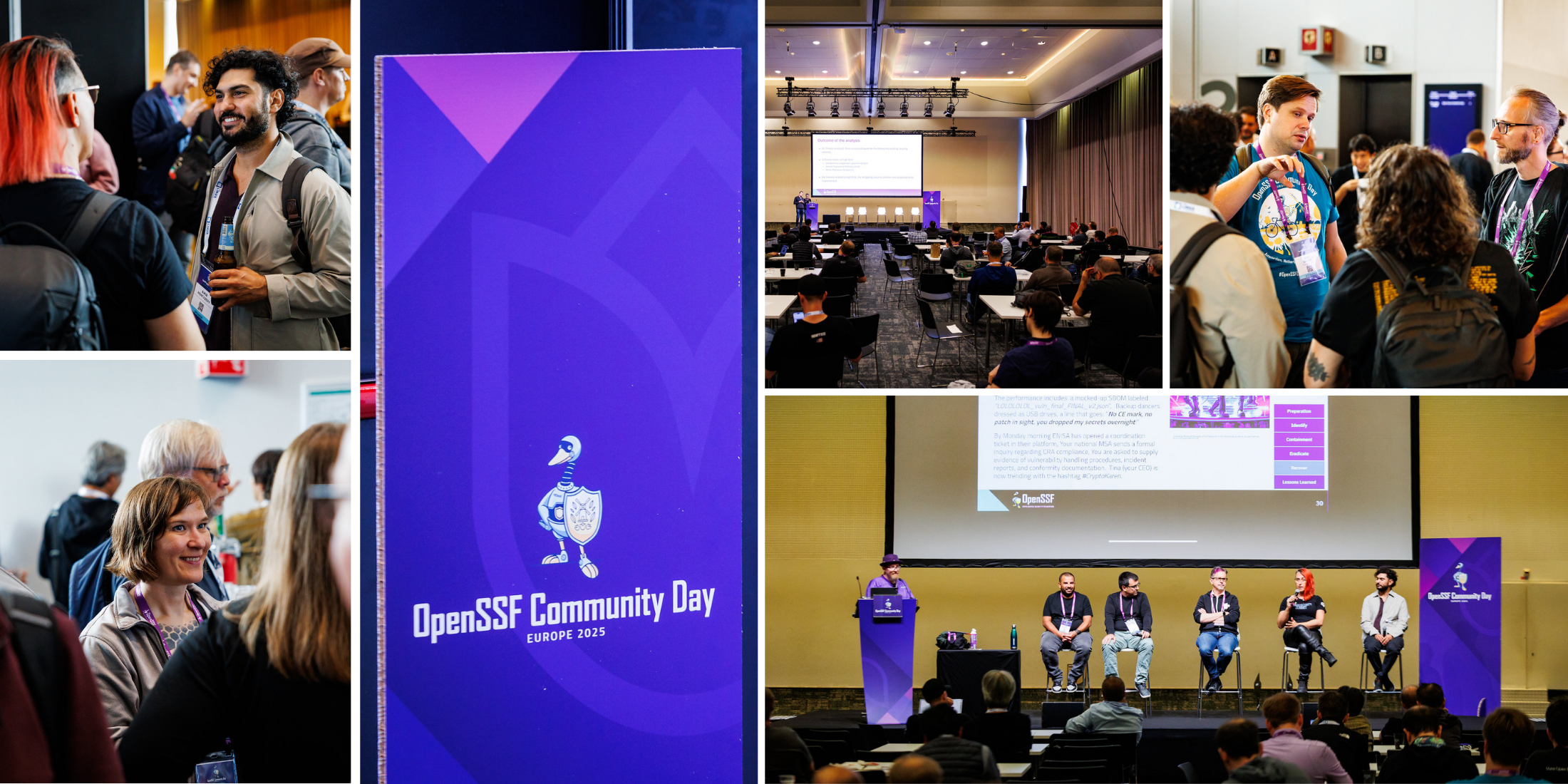 From August 25–28, 2025, the Linux Foundation hosted Open Source Summit Europe and OpenSSF Community Day Europe in Amsterdam, bringing together developers, maintainers, researchers, and policymakers to strengthen software supply chain security and align on global regulations like the EU Cyber Resilience Act (CRA). The week included strong engagement at the OpenSSF booth and sessions on compliance, transparency, proactive security, SBOM accuracy, and CRA readiness.
From August 25–28, 2025, the Linux Foundation hosted Open Source Summit Europe and OpenSSF Community Day Europe in Amsterdam, bringing together developers, maintainers, researchers, and policymakers to strengthen software supply chain security and align on global regulations like the EU Cyber Resilience Act (CRA). The week included strong engagement at the OpenSSF booth and sessions on compliance, transparency, proactive security, SBOM accuracy, and CRA readiness.
OpenSSF Community Day Europe celebrated milestones in AI security, public sector engagement, and the launch of Model Signing v1.0, while also honoring five community leaders with the Golden Egg Awards. Attendees explored topics ranging from GUAC+Trustify integration and post-quantum readiness to securing GitHub Actions, with an interactive Tabletop Exercise simulating a real-world incident response.
These gatherings highlighted the community’s progress and ongoing commitment to strengthening open source security. Read more.
At OpenSSF Community Day Europe, the Open Source Security Foundation honored this year’s Golden Egg Award recipients. Congratulations to Ben Cotton (Kusari), Kairo de Araujo (Eclipse Foundation), Katherine Druckman (Independent), Eddie Knight (Sonatype), and Georg Kunz (Ericsson) for their inspiring contributions.
With exceptional community engagement across continents and strategic efforts to secure the AI/ML pipeline, OpenSSF continues to build trust in open source at every level.
Read the full press release to explore the achievements, inspiring voices, and what’s next for global open source security.
Here you will find a snapshot of what’s new on the OpenSSF blog. For more stories, ideas, and updates, visit the blog section on our website.
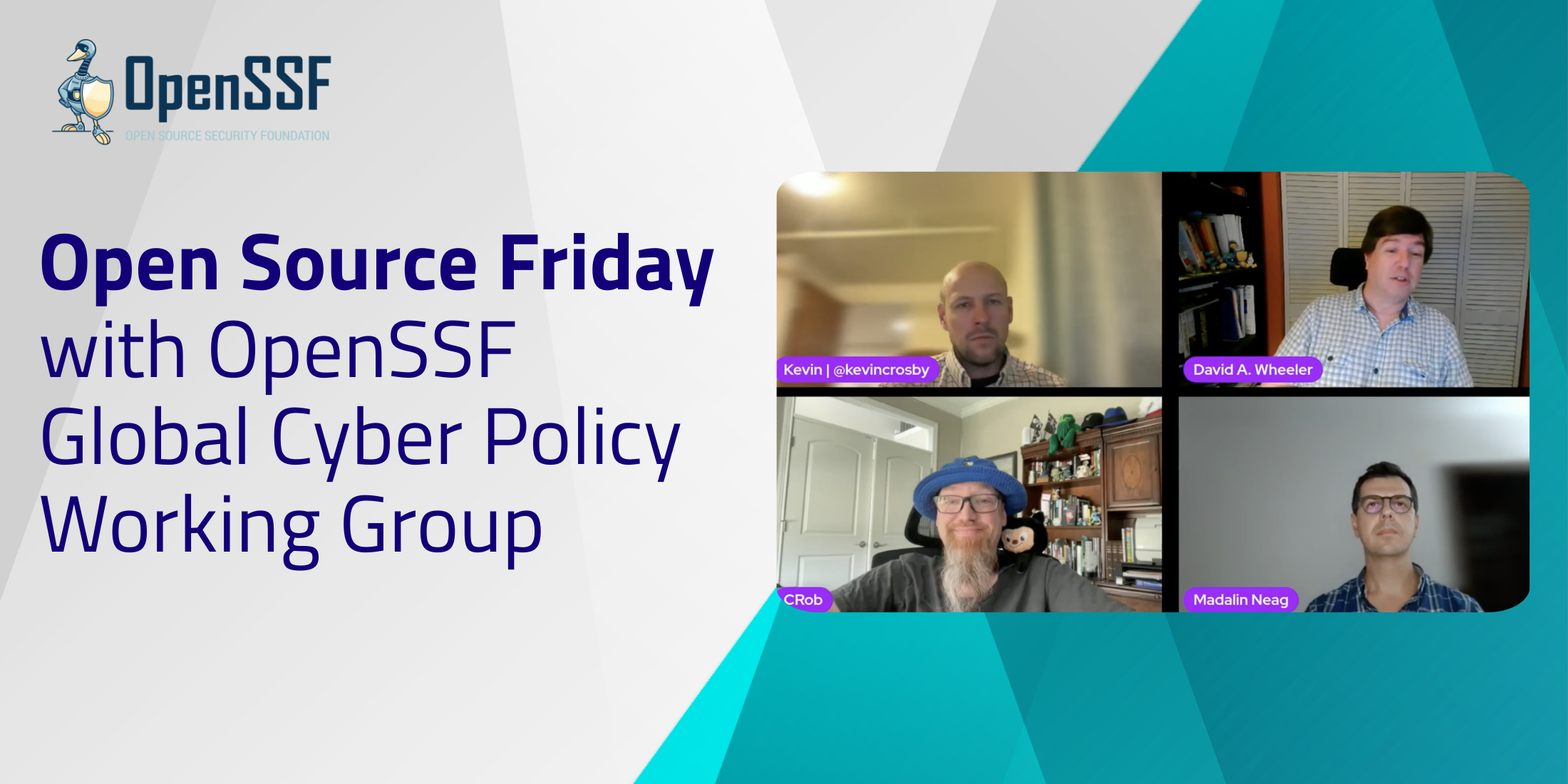 On August 15, 2025, GitHub’s Open Source Friday series spotlighted the OpenSSF Global Cyber Policy Working Group (WG) and the OSPS Baseline in a live session hosted by Kevin Crosby, GitHub. The panel featured OpenSSF’s Madalin Neag (EU Policy Advisor), Christopher Robinson (CRob) (Chief Security Architect) and David A. Wheeler (Director of Open Source Supply Chain Security) who discussed how the Working Group helps developers, maintainers, and policymakers navigate global cybersecurity regulations like the EU Cyber Resilience Act (CRA).
On August 15, 2025, GitHub’s Open Source Friday series spotlighted the OpenSSF Global Cyber Policy Working Group (WG) and the OSPS Baseline in a live session hosted by Kevin Crosby, GitHub. The panel featured OpenSSF’s Madalin Neag (EU Policy Advisor), Christopher Robinson (CRob) (Chief Security Architect) and David A. Wheeler (Director of Open Source Supply Chain Security) who discussed how the Working Group helps developers, maintainers, and policymakers navigate global cybersecurity regulations like the EU Cyber Resilience Act (CRA).
The conversation highlighted why the WG was created, how global policies affect open source, and the resources available to the community, including free training courses, the CRA Brief Guide, and the Security Baseline Framework. Panelists emphasized challenges such as awareness gaps, fragmented policies, and closed standards, while underscoring opportunities for collaboration, education, and open tooling.
As the CRA shapes global standards, the Working Group continues to track regulations, engage policymakers, and provide practical support to ensure the open source community is prepared for evolving cybersecurity requirements. Learn more and watch the recording.
SBOMs are becoming part of everyday software practice, but many teams still ask the same question: how do we turn SBOM data into decisions we can trust?
Our new whitepaper, “Improving Risk Management Decisions with SBOM Data,” answers that by tying SBOM information to concrete risk-management outcomes across engineering, security, legal, and operations. It shows how to align SBOM work with real business motivations like resiliency, release confidence, and compliance. It also describes what “decision-ready” SBOMs look like, and how to judge data quality. To learn more, download the Whitepaper.
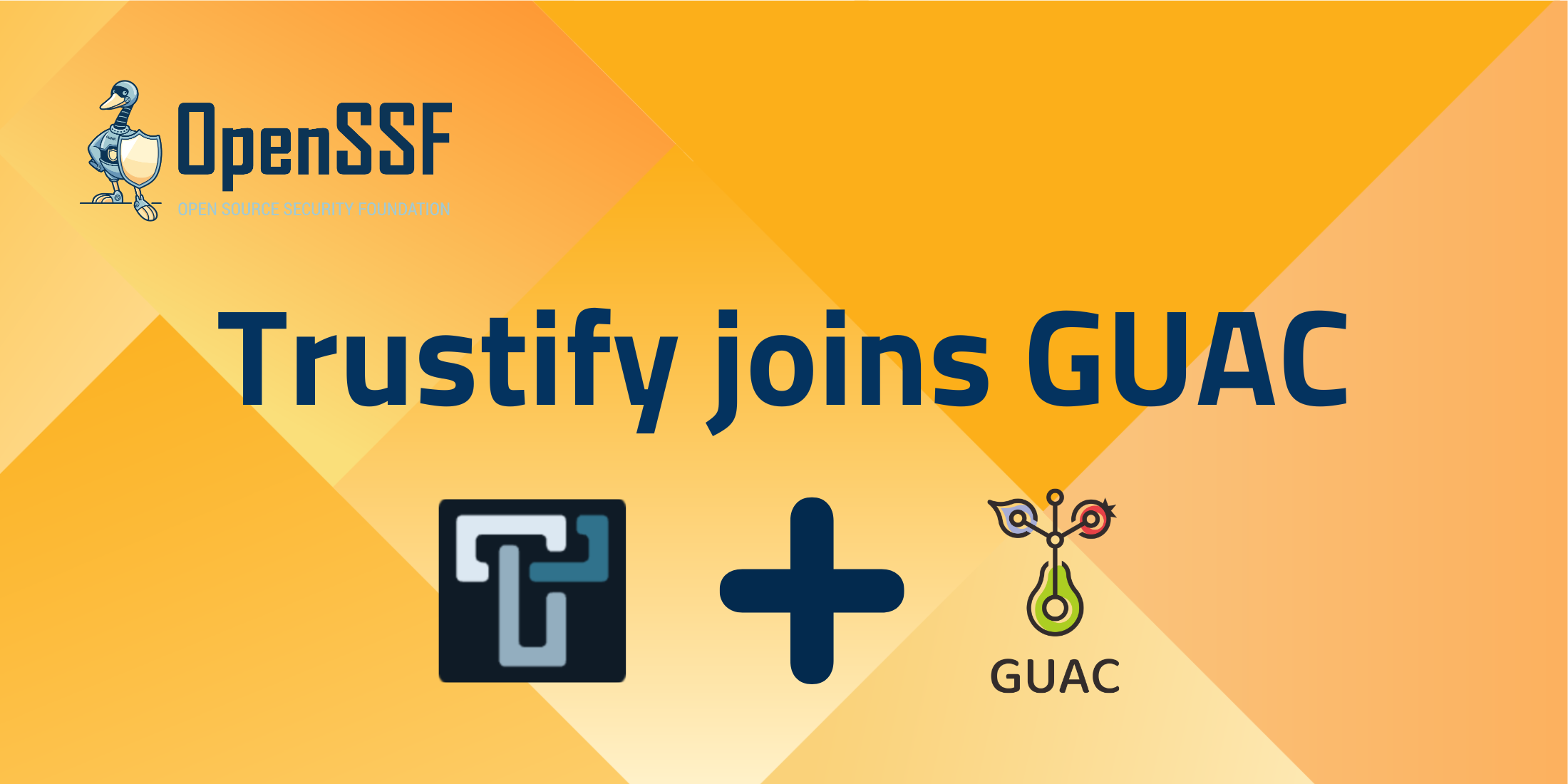 GUAC and Trustify are combining under the GUAC umbrella to tackle the challenges of consuming, processing, and utilizing supply chain security metadata at scale. With Red Hat’s contribution of Trustify, the unified community will serve as the central hub within OpenSSF for building and using supply chain knowledge graphs, defining standards, developing shared infrastructure, and fostering collaboration. Read more.
GUAC and Trustify are combining under the GUAC umbrella to tackle the challenges of consuming, processing, and utilizing supply chain security metadata at scale. With Red Hat’s contribution of Trustify, the unified community will serve as the central hub within OpenSSF for building and using supply chain knowledge graphs, defining standards, developing shared infrastructure, and fostering collaboration. Read more.
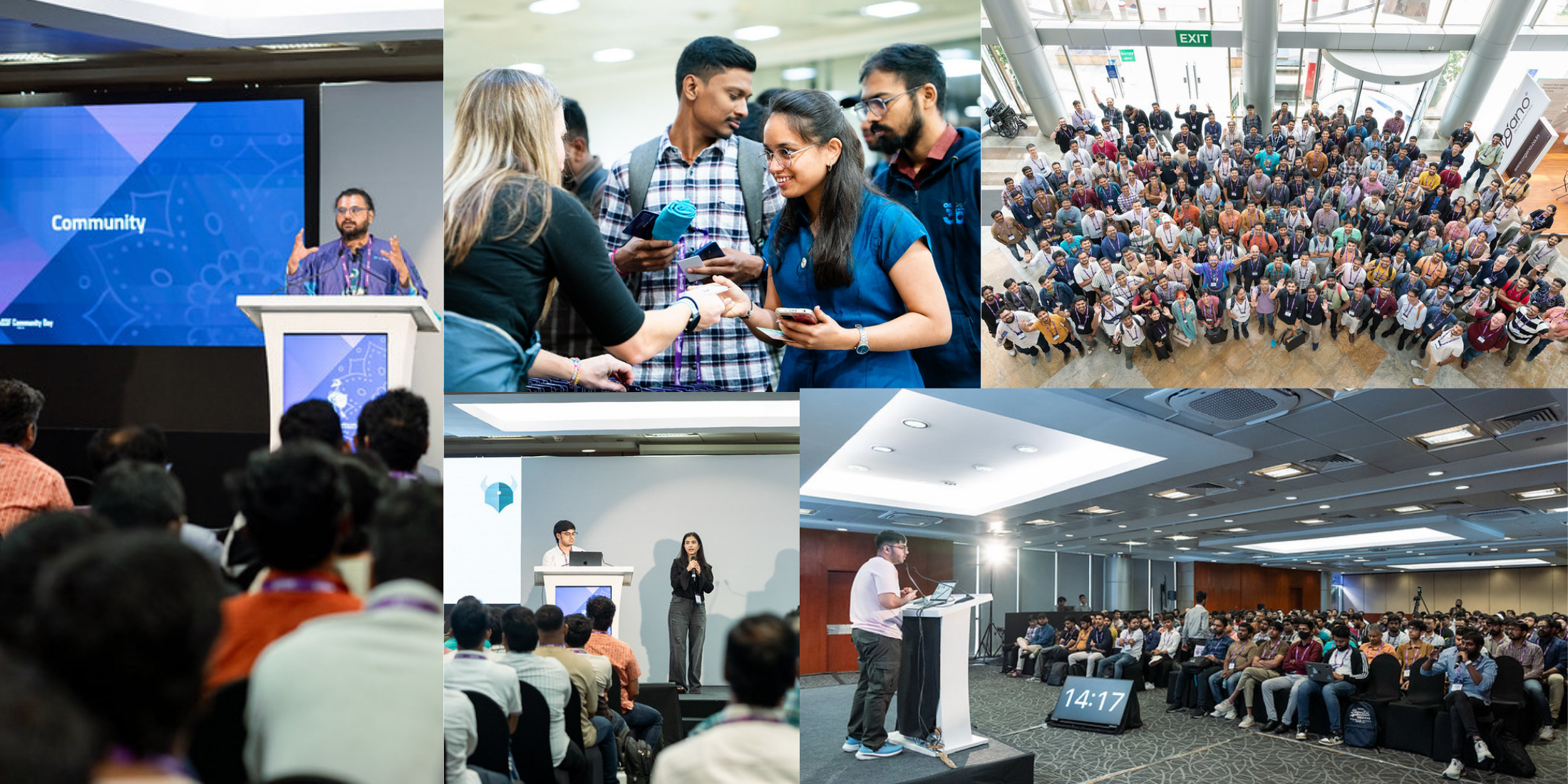 On August 4, 2025, OpenSSF hosted its second Community Day India in Hyderabad, co-located with KubeCon India. With 232 registrants and standing-room-only attendance, the event brought together open source enthusiasts, security experts, engineers, and students for a full day of learning, collaboration, and networking.
On August 4, 2025, OpenSSF hosted its second Community Day India in Hyderabad, co-located with KubeCon India. With 232 registrants and standing-room-only attendance, the event brought together open source enthusiasts, security experts, engineers, and students for a full day of learning, collaboration, and networking.
The event featured opening remarks from Ram Iyengar (OpenSSF Community Engagement Lead, India), followed by technical talks on container runtimes, AI-driven coding risks, post-quantum cryptography, supply chain security, SBOM compliance, and kernel-level enforcement. Sessions also highlighted tools for policy automation, malicious package detection, and vulnerability triage, as well as emerging approaches like chaos engineering and UEFI secure boot.
The event highlighted India’s growing role in global open source development and the importance of engaging local communities to address global security challenges. Read more.
In our recent blog, Avishay Balter, Principal SWE Lead at Microsoft and David A. Wheeler, Director, Open Source Supply Chain Security at OpenSSF introduce the OpenSSF “Security-Focused Guide for AI Code Assistant Instructions.” AI code assistants can speed development but also generate insecure or incorrect results if prompts are poorly written. The guide, created by the OpenSSF Best Practices and AI/ML Working Groups with contributors from Microsoft, Google, and Red Hat, shows how clear and security-focused instructions improve outcomes. It stands as a practical resource for developers today, while OpenSSF also develops a broader course (LFEL1012) on using AI code assistants securely.
This effort marks a step toward ensuring AI helps improve security instead of undermining it. Read more.
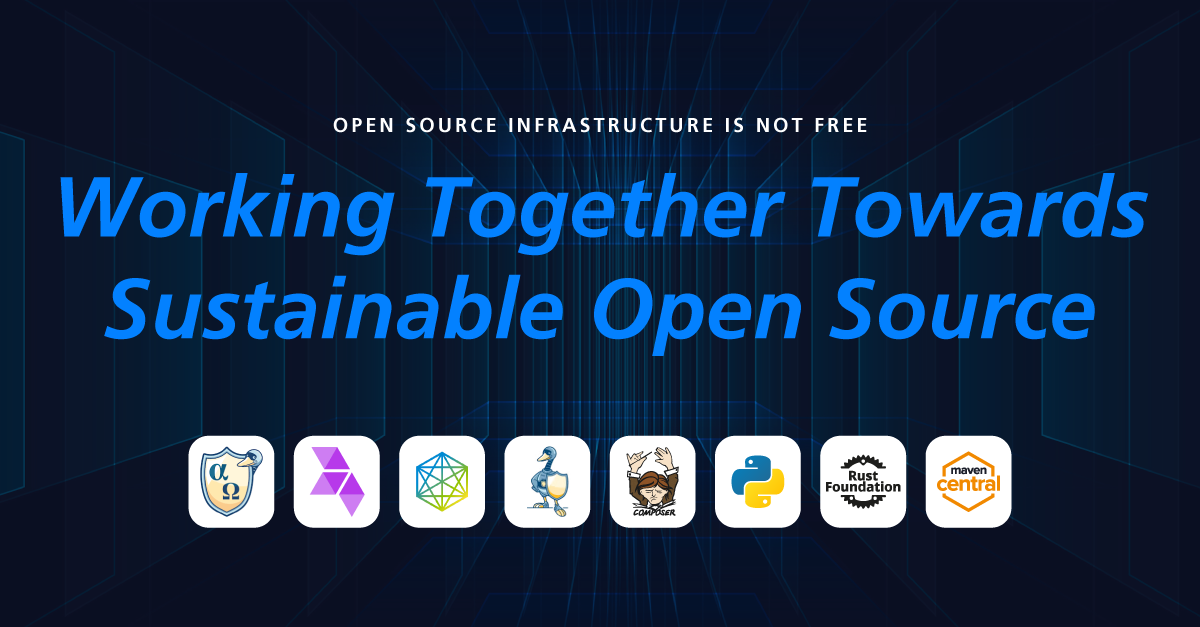 Public package registries and other shared services power modern software at global scale, but most costs are carried by a few stewards while commercial-scale users often contribute little. Our new open letter calls for practical models that align usage with responsibility — through partnerships, tiered access, and value-add options — so these systems remain strong, secure, and open to all.
Public package registries and other shared services power modern software at global scale, but most costs are carried by a few stewards while commercial-scale users often contribute little. Our new open letter calls for practical models that align usage with responsibility — through partnerships, tiered access, and value-add options — so these systems remain strong, secure, and open to all.
Signed by: OpenSSF, Alpha-Omega, Eclipse Foundation (Open VSX), OpenJS Foundation, Packagist (Composer), Python Software Foundation (PyPI), Rust Foundation (crates.io), Sonatype (Maven Central).
#38 – S2E15 Securing AI: A Conversation with Sarah Evans on OpenSSF’s AI/ML Initiatives
In this episode of What’s in the SOSS, Sarah Evans, Distinguished Engineer at Dell Technologies, discusses extending secure software practices to AI. She highlights the AI Model Signing project, the MLSecOps whitepaper with Ericsson, and efforts to identify new personas in AI/ML operations. Tune in to hear how OpenSSF is shaping the future of AI security.
#39 – S2E16 Racing Against Quantum: The Urgent Migration to Post-Quantum Cryptography with KeyFactor’s Crypto Experts
In this episode of What’s in the SOSS, host Yesenia talks with David Hook and Tomas Gustavsson from Keyfactor about the race to post-quantum cryptography. They explain quantum-safe algorithms, the importance of crypto agility, and why sectors like finance and supply chains are leading the way. Tune in to learn the real costs of migration and why organizations must start preparing now before it’s too late.
The Open Source Security Foundation (OpenSSF), together with Linux Foundation Education, provides a selection of free e-learning courses to help the open source community build stronger software security expertise. Learners can earn digital badges by completing offerings such as:
These are just a few of the many courses available for developers, managers, and decision-makers aiming to integrate security throughout the software development lifecycle.
Join us at OpenSSF Community Day in South Korea!
OpenSSF Community Days bring together security and open source experts to drive innovation in software security.
Connect with the OpenSSF Community at these key events:
There are a number of ways for individuals and organizations to participate in OpenSSF. Learn more here.
You’re invited to…
We want to get you the information you most want to see in your inbox. Missed our previous newsletters? Read here!
Have ideas or suggestions for next month’s newsletter about the OpenSSF? Let us know at marketing@openssf.org, and see you next month!
Regards,
The OpenSSF Team
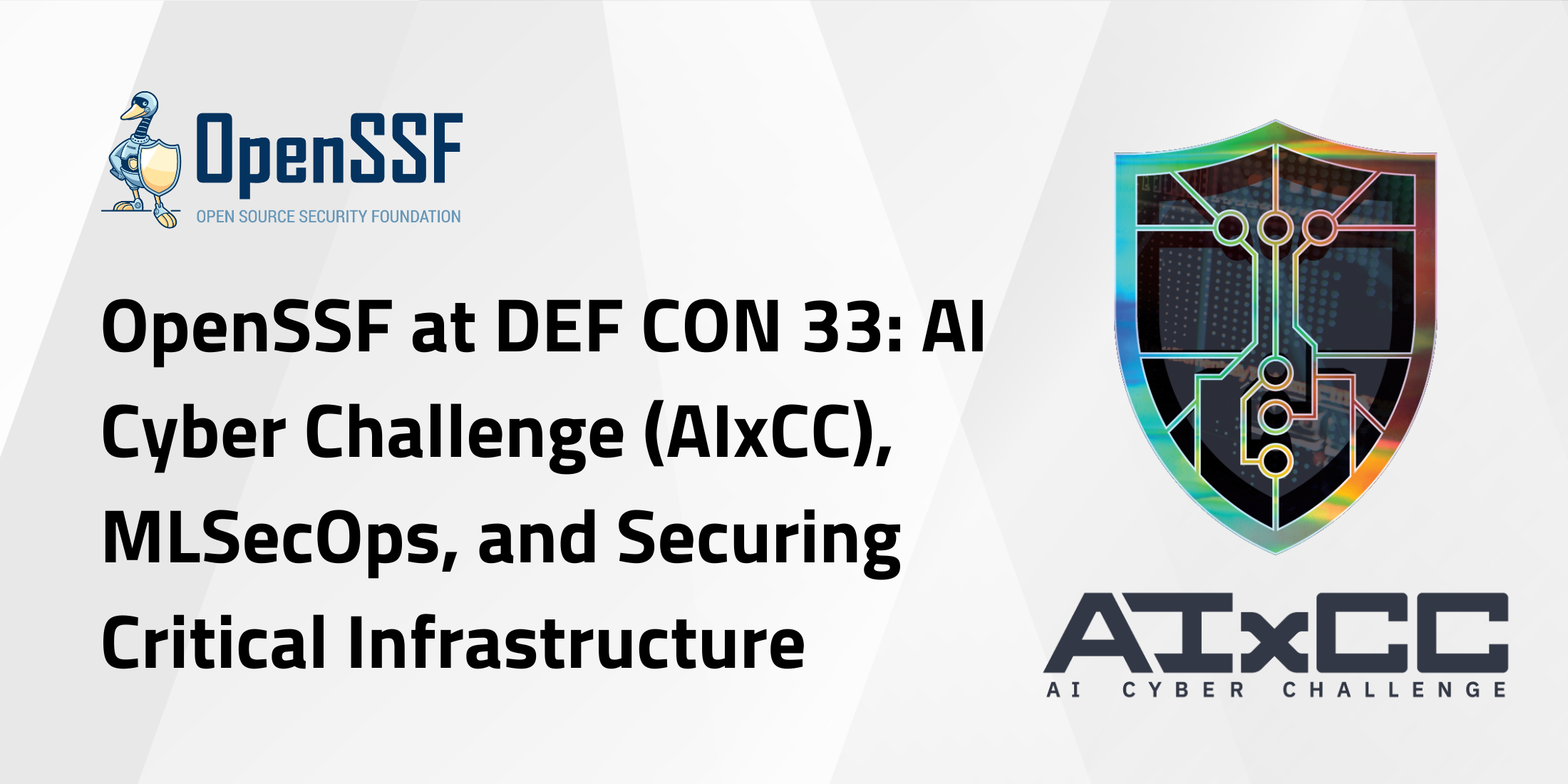
By Jeff Diecks
The OpenSSF team will be attending DEF CON 33, where the winners of the AI Cyber Challenge (AIxCC) will be announced. We will also host a panel discussion at the AIxCC village to introduce the concept of MLSecOps.
AIxCC, led by DARPA and ARPA-H, is a two-year competition focused on developing AI-enabled software to automatically identify and patch vulnerabilities in source code, particularly in open source software underpinning critical infrastructure.
OpenSSF is supporting AIxCC as a challenge advisor, guiding the competition to ensure its solutions benefit the open source community. We are actively working with DARPA and ARPA-H to open source the winning systems, infrastructure, and data from the competition, and are designing a program to facilitate their successful adoption and use by open source projects. At least four of the competitors’ Cyber Resilience Systems will be open sourced on Friday, August 8 at DEF CON. The remaining CRSs will also be open sourced soon after the event.
We will be hosting a panel talk at the AIxCC Village, “Applying DevSecOps Lessons to MLSecOps.” This presentation will delve into the evolving landscape of security with the advent of AI/ML applications.
The panelists for this discussion will be:
Just as DevSecOps integrated security practices into the Software Development Life Cycle (SDLC) to address critical software security gaps, Machine Learning Operations (MLOps) now needs to transition into MLSecOps. MLSecOps emphasizes integrating security practices throughout the ML development lifecycle, establishing security as a shared responsibility among ML developers, security practitioners, and operations teams. When thinking about securing MLOps using lessons learned from DevSecOps, the conversation includes open source tools from OpenSSF and other initiatives, such as Supply-Chain Levels for Software Artifacts (SLSA) and Sigstore, that can be extended to MLSecOps. This talk will explore some of those tools, as well as talk about potential tooling gaps the community can partner to close. Embracing this methodology enables early identification and mitigation of security risks, facilitating the development of secure and trustworthy ML models. Embracing MLSecOps methodology enables early identification and mitigation of security risks, facilitating the development of secure and trustworthy ML models.
We invite you to join us on Saturday, August 9, from 10:30-11:15 a.m. at the AIxCC Village Stage to learn more about how the lessons from DevSecOps can be applied to the unique challenges of securing AI/ML systems and to understand the importance of adopting an MLSecOps approach for a more secure future in open source software.
 Jeff Diecks is the Technical Program Manager for the AI Cyber Challenge (AIxCC) at the Open Source Security Foundation (OpenSSF). A participant in open source since 1999, he’s delivered digital products and applications for dozens of universities, six professional sports leagues, state governments, global media companies, non-profits, and corporate clients.
Jeff Diecks is the Technical Program Manager for the AI Cyber Challenge (AIxCC) at the Open Source Security Foundation (OpenSSF). A participant in open source since 1999, he’s delivered digital products and applications for dozens of universities, six professional sports leagues, state governments, global media companies, non-profits, and corporate clients.
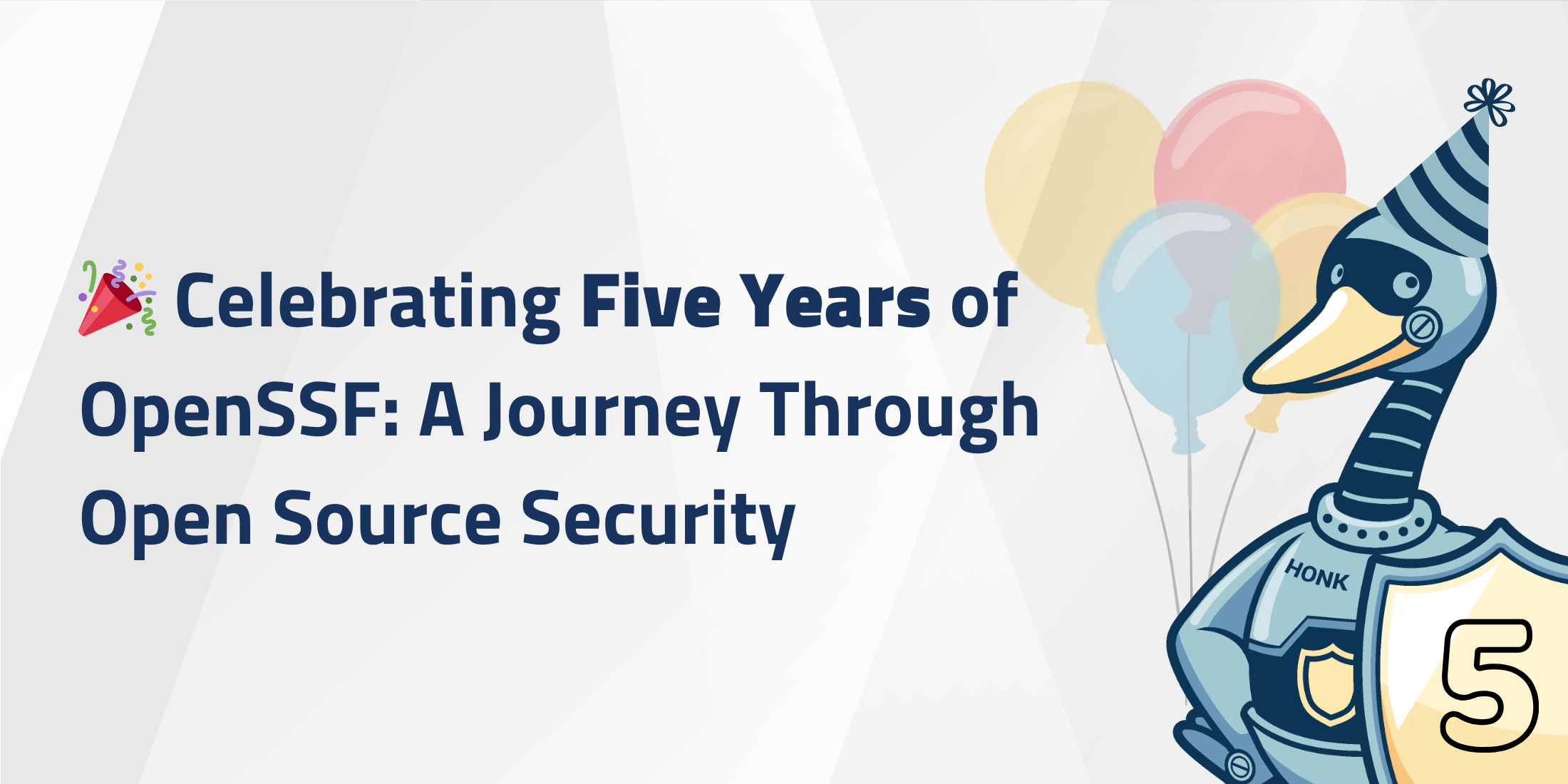
August 2025 marks five years since the official formation of the Open Source Security Foundation (OpenSSF). Born out of a critical need to secure the software supply chains and open source ecosystems powering global technology infrastructure, OpenSSF quickly emerged as a community-driven leader in open source security.
“OpenSSF was founded to unify and strengthen global efforts around securing open source software. In five years, we’ve built a collaborative foundation that reaches across industries, governments, and ecosystems. Together, we’re building a world where open source is not only powerful—but trusted.” — Steve Fernandez, General Manager, OpenSSF
OpenSSF was launched on August 3, 2020, consolidating earlier initiatives into a unified, cross-industry effort to protect open source projects. The urgency was clear—high-profile vulnerabilities such as Heartbleed served as stark reminders that collective action was essential to safeguard the digital infrastructure everyone depends on.
“From day one, OpenSSF has been about action—empowering the community to build and adopt real-world security solutions. Five years in, we’ve moved from ideas to impact. The work isn’t done, but the momentum is real, and the future is wide open.” — Christopher “CRob” Robinson, Chief Architect, OpenSSF
Over the past five years, OpenSSF has spearheaded critical initiatives that shaped the landscape of open source security:
2021 – Secure Software Development Fundamentals:
Launching free educational courses on edX, OpenSSF equipped developers globally with foundational security practices.
“When we launched our first free training course in secure software development, we had one goal: make security knowledge available to every software developer. Today, that same mission powers all of OpenSSF—equipping developers, maintainers, and communities with the tools they need to make open source software more secure for everyone.” — David A. Wheeler, Director, Open Source Supply Chain Security, Linux Foundation
2021 – Sigstore: Open Source Signing for Everyone:
Sigstore was launched to make cryptographic signing accessible to all open source developers, providing a free and automated way to verify the integrity and provenance of software artifacts and metadata.
“Being part of the OpenSSF has been crucial for the Sigstore project. It has allowed us to not only foster community growth, neutral governance, and engagement with the broader OSS ecosystem, but also given us the ability to coordinate with a myriad of in-house initiatives — like the securing software repos working group — to further our mission of software signing for everybody. As Sigstore continues to grow and become a core technology for software supply chain security, we believe that the OpenSSF is a great place to provide a stable, reliable, and mature service for the public benefit.”
— Santiago Torres-Arias, Assistant Professor at Purdue University and Sigstore TSC Chair Member
2021-2022 – Security with OpenSSF Scorecard & Criticality Score:
Innovative tools were introduced to automate and simplify assessing open source project security risks.
“The OpenSSF has been instrumental in transforming how the industry approaches open source security, particularly through initiatives like the Security Scorecard and Sigstore, which have improved software supply chain security for millions of developers. As we look ahead, AWS is committed to supporting OpenSSF’s mission of making open source software more secure by default, and we’re excited to help developers all over the world drive security innovation in their applications.” — Mark Ryland, Director, Amazon Security at AWS
2022 – Launch of Alpha-Omega:
Alpha-Omega (AO), an associated project of the OpenSSF launched in February 2022, is funded by Microsoft, Google, Amazon, and Citi. Its mission is to enhance the security of critical open source software by enabling sustainable improvements and ensuring vulnerabilities are identified and resolved quickly. Since its inception, the Alpha-Omega Fund has invested $14 million in open source security, supporting a range of projects including LLVM, Java, PHP, Jenkins, Airflow, OpenSSL, AI libraries, Homebrew, FreeBSD, Node.js, jQuery, RubyGems, and the Linux Kernel. It has also provided funding to key foundations and ecosystems such as the Apache Software Foundation (ASF), Eclipse Foundation, OpenJS Foundation, Python Foundation, and Rust Foundation.
2023 – SLSA v1.0 (Supply-chain Levels for Software Artifacts):
Setting clear and actionable standards for build integrity and provenance, SLSA was a turning point for software supply chain security and became essential in reducing vulnerabilities.
At the same time, community-driven tools like GUAC (Graph for Understanding Artifact Composition) built on SLSA’s principles, unlocking deep visibility into software metadata, making it more usable, actionable and connecting the dots across provenance, SBOMs and in-toto security attestations.
“Projects like GUAC demonstrate how open source innovation can make software security both scalable and practical. Kusari is proud to have played a role in these milestones, helping to strengthen the resiliency of the open source software ecosystem.”
— Michael Lieberman, CTO and Co-founder at Kusari and Governing Board member
2024 – Principles for Package Repository Security:
Offering a voluntary, community-driven security maturity model to strengthen the resilience of software ecosystems.
“Developers around the world rely daily on package repositories for secure distribution of open source software. It’s critical that we listen to the maintainers of these systems and provide support in a way that works for them. We were happy to work with these maintainers to develop the Principles for Package Repository Security, to help them put together security roadmaps and provide a reference in funding requests.” — Zach Steindler, co-chair of Securing Software Repositories Working Group, Principal Engineer, GitHub
2025
OSPS Baseline:
This initiative brought tiered security requirements into the AI space, quickly adopted by groundbreaking projects such as GUAC, OpenTelemetry, and bomctl.
“The Open Source Project Security Baseline was born from real use cases, with projects needing robust standardized guidance around how to best secure their development processes. OpenSSF has not only been the best topical location for contributors from around the world to gather — the foundation has gone above and beyond by providing project support to extend the content, promote the concept, and elevate Baseline from a simple control catalog into a robust community and ecosystem.” — Eddie Knight, OSPO Lead, Sonatype
AI/ML Security Working Group:
The MLSecOps White Paper from the AI/ML Security Working Group marks a major step in securing machine learning pipelines and guiding the future of trustworthy AI.
“The AI/ML working group tackles problems at the confluence of security and AI. While the AI world is moving at a breakneck pace, the security problems that we are tackling in the traditional software world are also relevant. Given that AI can increase the impact of a security vulnerability, we need to handle them with determination. The working group has worked on securing LLM generating code, model signing and a new white paper for MLSecOps, among many other interesting things.” — Mihai Maruseac, co-chair of AI/ML Security Working Group, Staff Software Engineer, Google
OpenSSF’s role rapidly expanded beyond tooling, becoming influential in global policy dialogues, including advising the White House on software security and contributing to critical policy conversations such as the EU’s Cyber Resilience Act (CRA).
OpenSSF also continues to invest in community-building and education initiatives. This year, the Foundation launched its inaugural Summer Mentorship Program, welcoming its first cohort of mentees working directly with technical project leads to gain hands-on experience in open source security.
The Foundation also supported the publication of the Compiler Options Hardening Guide for C and C++, originally contributed by Ericsson, to help developers and toolchains apply secure-by-default compilation practices—especially critical in memory-unsafe languages.
In addition, OpenSSF has contributed to improving vulnerability disclosure practices across the ecosystem, offering guidance and tools that support maintainers in navigating CVEs, responsible disclosure, and downstream communication.
“The OpenSSF is uniquely positioned to advise on considerations, technical elements, and community impact public policy decisions have not only on open source, but also on the complex reality of implementing cybersecurity to a diverse and global technical sector. In the past 5 years, OpenSSF has been building a community of well-informed open source security experts that can advise regulations but also challenge and adapt security frameworks, law, and regulation to support open source projects in raising their security posture through transparency and open collaboration; hallmarks of open source culture.” — Emily Fox, Portfolio Security Architect, Red Hat
Key community members, from long-standing contributors to new voices, have shaped OpenSSF’s journey:
OG Voices:
“Microsoft joined OpenSSF as a founding member, committed to advancing secure open source development. Over the past five years, OpenSSF has driven industry collaboration on security through initiatives like Alpha-Omega, SLSA, Scorecard, Secure Software Development training, and global policy efforts such as the Cyber Resilience Act. Together, we’ve improved memory safety, supply chain integrity, and secure-by-design practices, demonstrating that collaboration is key to security. We look forward to many more security advancements as we continue our partnership.” — Mark Russinovich, CTO, Deputy CISO, and Technical Fellow, Microsoft Azure
OpenSSF Leadership Perspective:
“OpenSSF’s strength comes from the people behind it—builders, advocates, and champions from around the world working toward a safer open source future. This milestone isn’t just a celebration of what we’ve accomplished, but of the community we’ve built together.” — Adrianne Marcum, Chief of Staff, OpenSSF
Community Perspectives:
“After 5 years of hard work, the OpenSSF stands as a global force for securing the critical open-source that we all use. Here’s to five years of uniting communities, hardening the software supply chain, and driving a safer digital future.” Tracy Ragan, CEO, DeployHub
“I found OpenSSF through my own curiosity, not by invitation, and I stayed because of the warmth, support, and shared mission I discovered. From contributing to the BEAR Working Group to receiving real backing for opportunities, the community consistently shows up for its members. It’s more than a project; it’s a space where people are supported, valued, and empowered to grow.” Ijeoma Onwuka, Independent Contributor
As we celebrate our fifth anniversary, OpenSSF is preparing for a future increasingly influenced by AI-driven tools and global collaboration. Community members across the globe envision greater adoption of secure AI practices, expanded policy influence, and deeper, inclusive international partnerships.
“As we celebrate OpenSSF’s 5th Anniversary, I’m energized by how our vision has grown into a thriving global movement of developers, maintainers, security researchers, and organizations all united by our shared mission. Looking ahead we’re hoping to cultivate our community’s knowledge and empower growth through stronger collaboration and more inclusive pathways for contributors.” – Stacey Potter, Community Manager, OpenSSF
We invite you to share your memories, contribute your voice, and become part of the next chapter in securing open source software.
Here’s to many more years ahead! 🎉
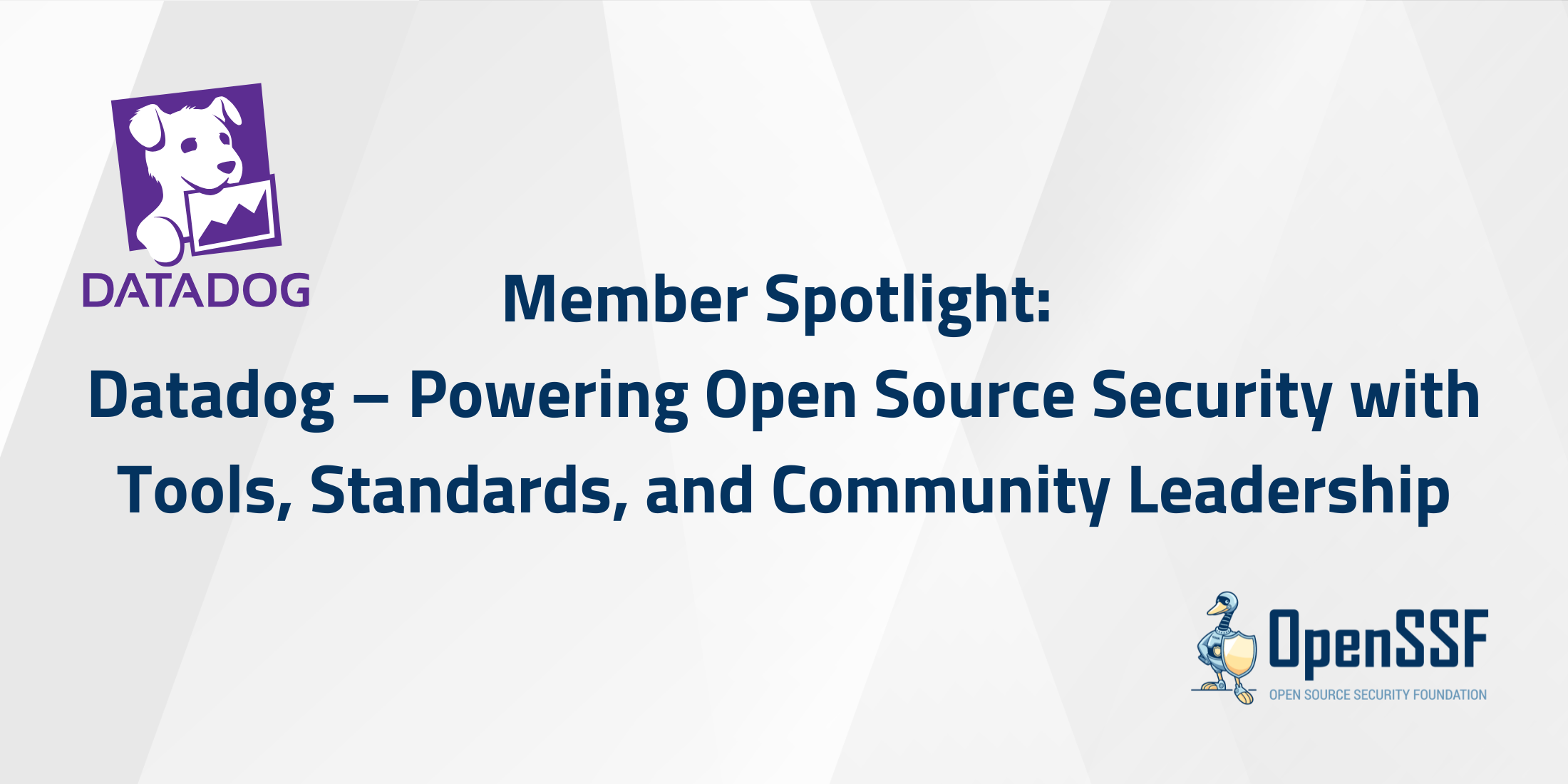
Datadog, a leading cloud-scale observability and security platform, joined the Open Source Security Foundation (OpenSSF) as a Premier Member in July, 2024. With both executive leadership and deep technical involvement, Datadog has rapidly become a force in advancing secure open source practices across the industry.
GuardDog: Open Source Threat Detection
In early 2025, Datadog launched GuardDog, a Python-based open source tool that scans package ecosystems like npm, PyPI, and Go for signs of malicious behavior. GuardDog is backed by a publicly available threat dataset, giving developers and organizations real-time visibility into emerging supply chain risks.
This contribution directly supports OpenSSF’s mission to provide practical tools that harden open source ecosystems against common attack vectors—while promoting transparency and shared defense.
Datadog actively supports the open source security ecosystem through its engineering efforts, tooling contributions, and participation in the OpenSSF community:
These collaborations demonstrate Datadog’s investment in long-term, community-driven approaches to open source security.
Datadog takes the stage at OpenSSF Community Day North America on Thursday, June 26, 2025, in Denver, CO, co-located with Open Source Summit North America.
They’ll be presenting alongside Intel Labs in the session:
Talk Title: Harnessing In-toto Attestations for Security and Compliance With Next-gen Policies
Time: 3:10–3:30 PM MDT
Location: Bluebird Ballroom 3A
Speakers:
This session dives into the evolution of the in-toto Attestation Framework, spotlighting new policy standards that make it easier for consumers and auditors to derive meaningful insights from authenticated metadata—such as SBOMs and SLSA Build Provenance. Attendees will see how the latest policy framework bridges gaps in compatibility and usability with a flexible, real-world-ready approach to securing complex software supply chains.
Register now and connect with Datadog, Intel Labs, and fellow open source security leaders in Denver.
By contributing to secure development frameworks, creating open source tooling, and educating the broader community, Datadog exemplifies what it means to be an OpenSSF Premier Member. Their work is hands-on, standards-driven, and deeply collaborative—helping make open source safer for everyone.
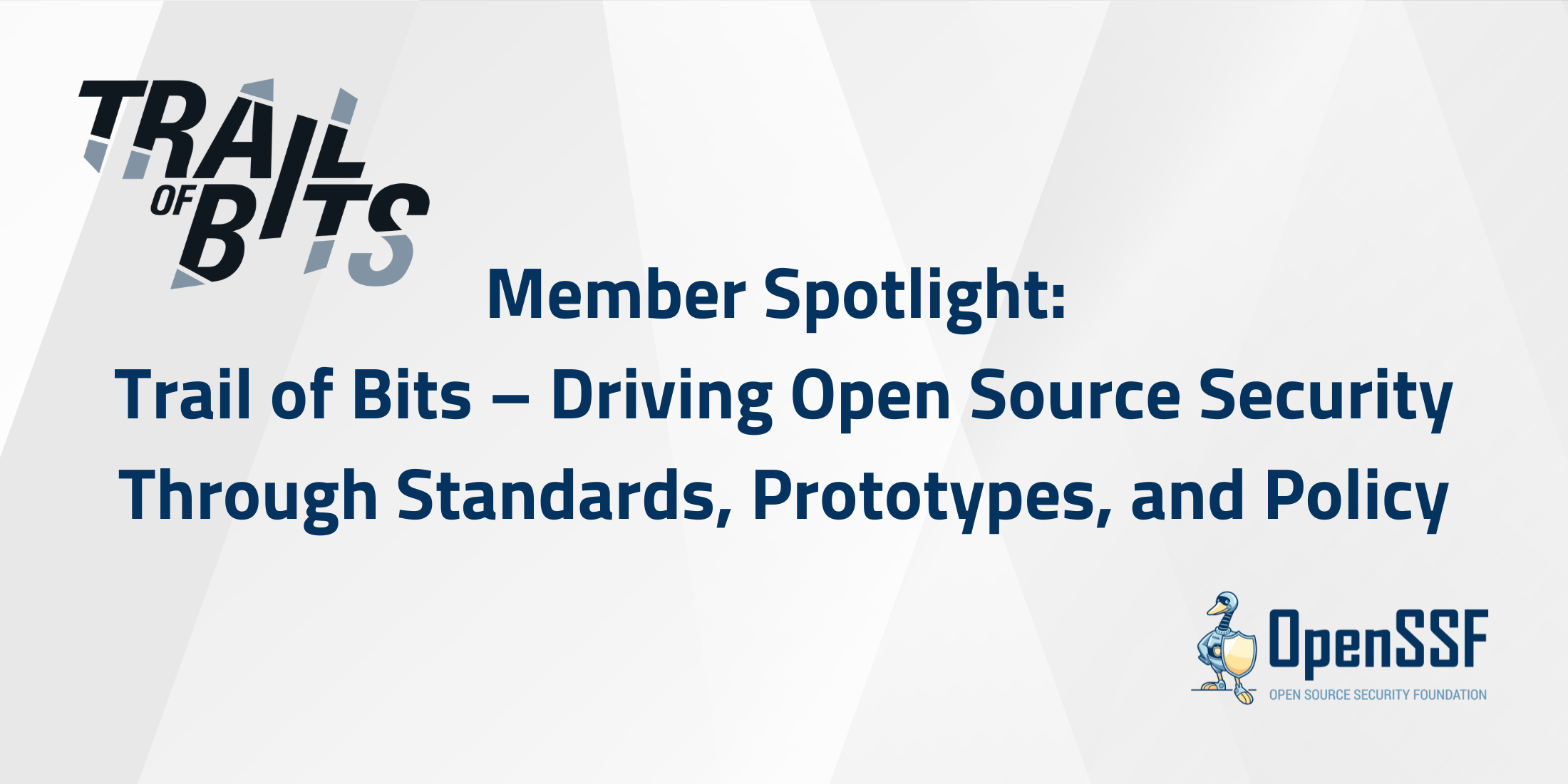
Trail of Bits is a leading cybersecurity research, engineering, and consulting firm that works with some of the most security-conscious organizations in the world—including Facebook, government agencies like DARPA, and prominent cryptocurrency protocols. Founded in 2012, each part of the company focused on open sourcing their work- tools,research, and audits wherever possible. Trail of Bits also maintains a dedicated research division focused on advancing industry-wide security practices, with specialized teams focused on securing open source infrastructure that both their clients and the broader technology ecosystem depend upon.
Trail of Bits’ work spans both policy and practice, often bridging emerging security needs with real-world implementation. Here are a few of the ways they’ve made an impact:
As open source continues to serve as the backbone of digital infrastructure, organizations like Trail of Bits play a vital role in making it more secure, reliable, and transparent. Their ability to influence both upstream policy (like PEPs) and downstream implementation (like OpenSSF Scorecard and Sigstore) helps move the entire ecosystem forward.
Trail of Bits remains actively engaged in exploring new opportunities for impact—whether that’s contributing technical guidance, launching prototypes, or leading standards discussions. Their work reflects the spirit of OpenSSF collaboration: practical, community-oriented, and always evolving.
Visit trailofbits.com to explore their research and tooling.
To get involved in OpenSSF projects or working groups, visit openssf.org.
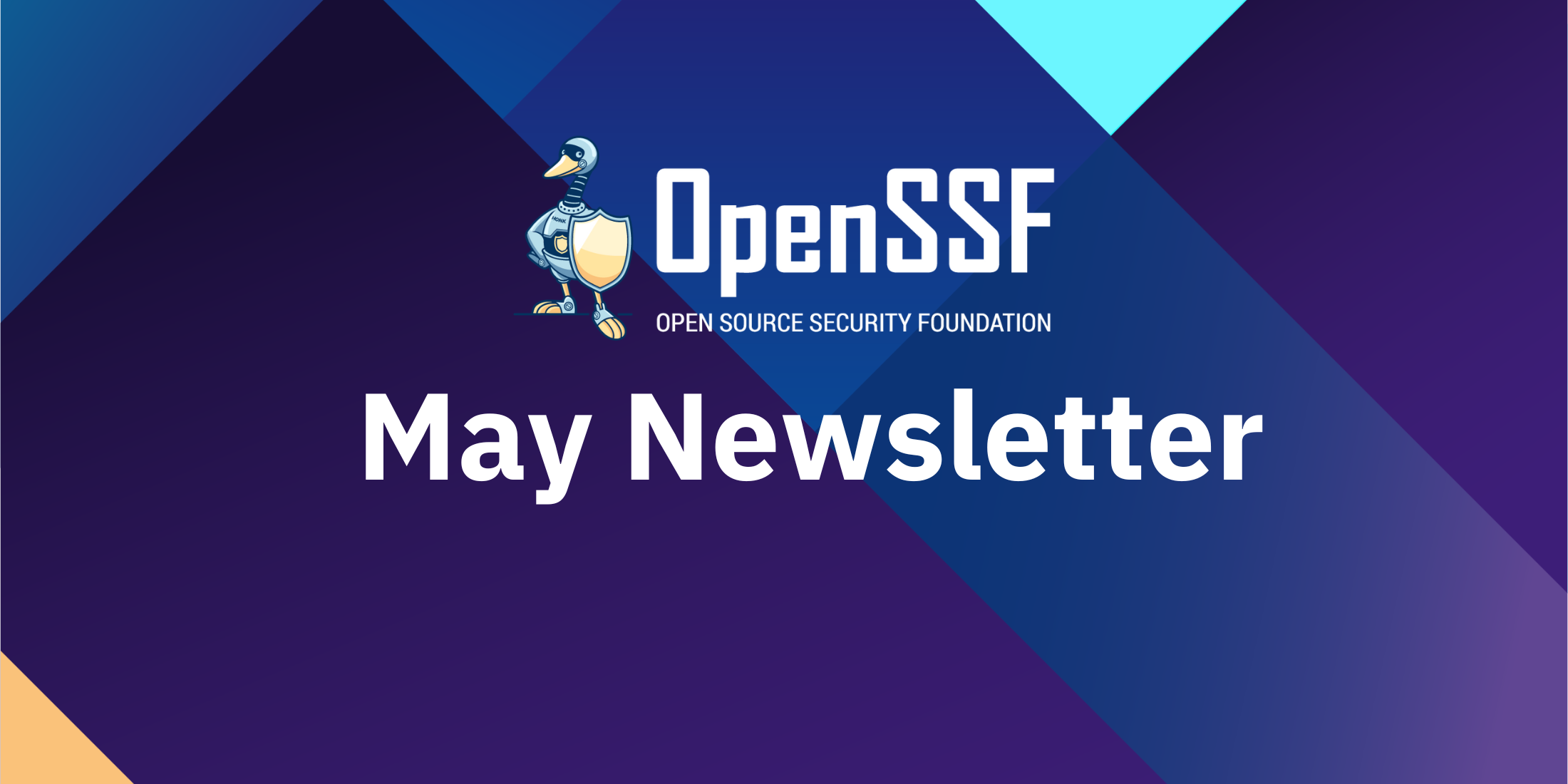
Welcome to the May 2025 edition of the OpenSSF Newsletter! Here’s a roundup of the latest developments, key events, and upcoming opportunities in the Open Source Security community.
Here’s a quick summary of this month’s highlights: the OpenSSF Tech Talk showed how the Security Baseline helps projects enhance compliance and resilience; the Best Practices WG released the guide “Simplifying Software Component Updates” to prevent API‐compatibility vulnerabilities; the CFP for Community Day Europe (Amsterdam, August 28) closes May 26; the Cybersecurity Skills Framework offers a free, customizable way to align job roles with practical security skills (webinar June 11); Ericsson’s C/C++ Compiler Hardening Guide, now jointly maintained with OpenSSF, demonstrates the power of community-driven security practices; three fresh podcast episodes are live (#29 Stacey Potter, #30 GitHub’s SOS Fund, and #31 Cybersecurity Framework Launch); and our community continues to buzz with WG updates, upcoming Community Days in Tokyo, Denver, Hyderabad, Amsterdam and Seoul, and CFP for Open Source SecurityCon.
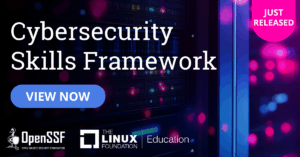
The Linux Foundation and OpenSSF have released the Cybersecurity Skills Framework, a customizable global reference guide that aligns IT job roles with practical cybersecurity competencies. The framework defines foundational, intermediate, and advanced proficiency levels mapped to standards like DoD 8140, CISA NICE, and ICT e-CF, enabling organizations to assess and build security capabilities across job roles.
Developed through global research and community feedback, the framework empowers enterprise leaders to close skills gaps, strengthen security culture, and systematically reduce cyber risk. Listen to the podcast, attend the webinar on Wednesday, June 11 at 11:00 am EDT. Learn more.
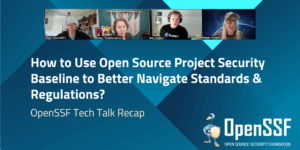
The Open Source Security Foundation (OpenSSF) hosted a Tech Talk titled “How to Use the OSPS Baseline to Better Navigate Standards and Regulations” to help maintainers, contributors, and organizations apply the OSPS Baseline in real-world projects. This session offered practical guidance on enhancing compliance, reducing risk, and building more resilient open source software. Learn more.
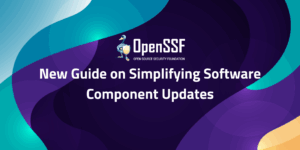
The Open Source Security Foundation (OpenSSF) Best Practices Working Group has released the new guide Simplifying Software Component Updates. This guide by David A. Wheeler (The Linux Foundation) and Georg Kunz (Ericsson) gives software producers and consumers practical steps to simplify component compatibility. Applying the principles in this guide will eliminate many vulnerabilities in software. Backward-incompatible changes to an application programmer interface (API) often lead to unaddressed security vulnerabilities. Read the blog.
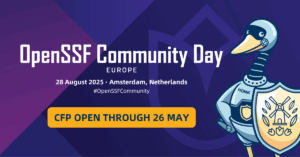
OpenSSF Community Day Europe takes place on Thursday, 28 August in Amsterdam, Netherlands, co-located with Open Source Summit EU. This event brings together contributors, maintainers, practitioners, and researchers to collaborate on securing the open source software we all rely on. Submit your proposals by 26 May 2025 on topics such as AI and ML in security, cyber resilience and supply chain security, OSS signatures and verification, real-world case studies, regulatory compliance, and enhanced security tooling. Learn more.
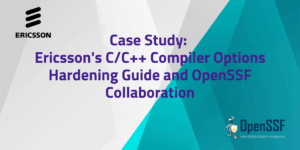
This case study highlights Ericsson’s collaboration with the OpenSSF on the C/C++ Compiler Options Hardening Guide, a pragmatic resource that maps compiler hardening flags to their performance and security impacts. Originally drafted by Ericsson’s product security team and donated to the OpenSSF, the guide is now maintained in the OpenSSF Best Practices Working Group. Community feedback from compiler maintainers, Linux distribution contributors, and projects like Wireshark, Chainguard, and CPython has refined its recommendations, leading to internal adoption at Ericsson and broader ecosystem uptake.
Ericsson’s work demonstrates how open sourcing practical security guidance and engaging the community can drive real improvements in C/C++ code hardening across the industry. Read the case study.
#29 – S2E06 “Showing Up Fully: Meet OpenSSF’s new Community Manager, Stacey Potter”: Meet Stacey Potter, OpenSSF’s new Community Manager, as she shares her journey into open source and her community first mindset.
#30 S2E07 “Scaling Security: Inside the GitHub Securing Open Source Software Fund”: Kevin Crosby and Xavier René-Corail from GitHub discuss the Securing Open Source SOS Fund, its $10K stipends, lessons from cohort 1, and maintainer month.
#31 – S2E08 “Cybersecurity Framework Launch”: Delve into the development of the Cybersecurity Skills Framework, emphasizing the need for continuous learning and community engagement in the tech industry.
Join us at OpenSSF Community Day Events in North America, India, Japan, Korea and Europe!
OpenSSF Community Days bring together security and open source experts to drive innovation in software security.
Connect with the OpenSSF Community at these key events:
There are a number of ways for individuals and organizations to participate in OpenSSF. Learn more here.
You’re invited to…
We want to get you the information you most want to see in your inbox. Missed our previous newsletters? Read here!
Have ideas or suggestions for next month’s newsletter about the OpenSSF? Let us know at marketing@openssf.org, and see you next month!
Regards,
The OpenSSF Team
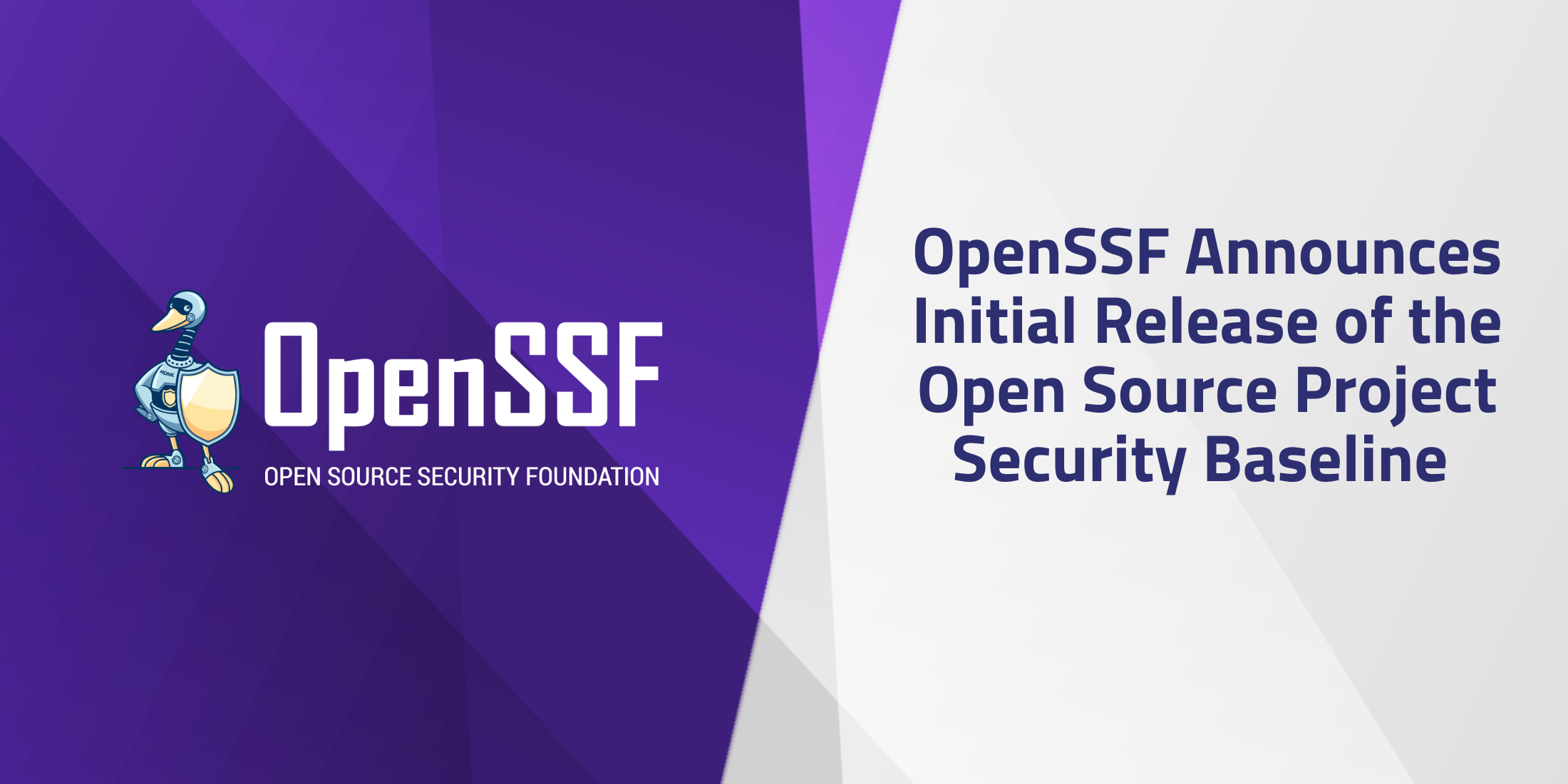
New Initiative Aims to Enhance Open Source Software Security Through Tiered Best Practices
SAN FRANCISCO – February 25, 2025 – The Open Source Security Foundation (OpenSSF) is pleased to announce the initial release of the Open Source Project Security Baseline (OSPS Baseline). The Baseline initiative provides a structured set of security requirements aligned with international cybersecurity frameworks, standards, and regulations, aiming to bolster the security posture of open source software projects.
“The OSPS Baseline release is a significant milestone in advancing security initiatives within the open source ecosystem,” said Christopher Robinson, Chief Security Architect at OpenSSF. “We’re excited to roll out OSPS Baseline following community testing and validation — we are confident that these security best practices are both practical and impactful across open source projects.”
The OSPS Baseline offers a tiered framework of security practices that evolve with project maturity. It compiles existing guidance from OpenSSF and other expert groups, outlining tasks, processes, artifacts, and configurations that enhance software development and consumption security. By adhering to the Baseline, developers can lay a foundation that supports compliance with global cybersecurity regulations, such as the EU Cyber Resilience Act (CRA) and U.S. National Institute of Standards and Technology (NIST) Secure Software Development Framework (SSDF).
“We’ve gotten helpful feedback from projects involved in the pilot rollout, including adoption commitments from GUAC, OpenVEX, bomctl, and Open Telemetry,” said Stacey Potter, Independent Open Source Community Manager, after helping lead the OSPS Baseline pilot efforts. “We know it can be tough to navigate all the security standards out there, so we built a framework that grows with your project. Our goal is to take the guesswork out of it and help maintainers feel confident about where they stand, without adding extra stress. It’s all about empowering the community and making open source more secure for everyone!”
“I’m excited to see the release of OSPS Baseline,” said Ben Cotton, Open Source Community Lead at Kusari & OSPS Baseline co-maintainer. “This effort provides actionable, practical guidance to help developers achieve appropriate security levels for their projects. Too often, security advice is vague or impractical, but Baseline aims to change that. Every improvement to open source security strengthens the modern software ecosystem, making it safer for everyone.”
OpenSSF invites open source developers, maintainers, and organizations to make use of the OSPS Baseline. Through engaging with this initiative, stakeholders can also contribute to refining the framework and promoting widespread adoption of security best practices in the open source community.
For more information and to get involved, please visit the OSPS Baseline website or GitHub.
Supporting Quotes:
“The OSPS Baseline release is an important step toward efficiently addressing the security and resilience of open source projects. Open source stewards, manufacturers who rely on open source, and end users will all benefit long-term as this community-defined criteria shines light on project security best practices.”
– Eddie Knight, Open Source Program Office Lead at Sonatype and OSPS Baseline Project Lead
“We applaud the launch of the OSPS Baseline as a crucial initiative in bolstering the security landscape of open source projects. At TestifySec, we recognize the importance of robust security frameworks like the OSPS Baseline in safeguarding software integrity and enhancing resilience against evolving cyber threats. We look forward to leveraging these guidelines to further fortify our commitment to delivering secure solutions for our clients and the broader open source community.”
– Cole Kennedy, Co-Founder and CEO of TestifySec
“Security is a fundamental priority for the cloud native ecosystem, and the OSPS Baseline represents a major step forward in providing clear, actionable guidance for projects of all sizes. By establishing a tiered framework that evolves with project maturity, OSPS Baseline empowers maintainers and contributors to adopt security best practices that are scalable and sustainable. The CNCF is proud to support efforts like this that strengthen open source software at every level of development and we look forward to collaborating with the OpenSSF on adoption.”
– Chris Aniszczyk, Chief Technology Officer, Cloud Native Computing Foundation
“As open source has become integral in most of our technology stacks, it has become increasingly critical to streamline and standardize the security expectations between open source maintainers and consumers. By synthesizing the requirements and controls from a variety of laws, regulations, and standards, the OpenSSF Baseline provides a clear roadmap for open source consumers to understand their security foundations.”
– Evan Anderson, Principal Software Engineer at Stacklok and Open Source Maintainer
“The Open Source Project Security Baseline is a vital tool for enhancing the security of open source projects. By offering a comprehensive set of actionable measures, the Security Baseline provides effective guidance for all stakeholders in the open source ecosystem – manufacturers, stewards, and projects alike – to collaboratively assume responsibility and take meaningful steps to secure the open source supply chain on which we all rely.”
– Per Beming, Chief Standardization Officer at Ericsson
***
About the OpenSSF
The Open Source Security Foundation (OpenSSF) is a cross-industry initiative by the Linux Foundation that brings together the industry’s most important open source security initiatives and the individuals and companies that support them. The OpenSSF is committed to collaboration and working both upstream and with existing communities to advance open source security for all. For more information, please visit us at openssf.org.
Media Contact
Noah Lehman
The Linux Foundation
nlehman@linuxfoundation.org
CRob is joined by Michael Lieberman, CTO and co-founder of Kusari, about the importance of supply chain security in the open source ecosystem. They discuss Michael’s journey in open source, his contributions to projects like SLSA and GUAC and the future of supply chain security.
Michael Lieberman soundbite (00:01)
I think for the downstream consumers, it’s one thing to do the security. It’s another thing to have folks who are consuming the software know, yes, I feel confident that they’re actually doing the right things because I’m getting signed in an atttested documentation that I can tie back to the maintainers.
CRob (00:18)
Hello, everybody. I’m CRob. I do security stuff on the internet, amongst other things, and I also am a community member and chief security architect for the Open Source Security Foundation. And one of the amazing things I get to do is host “What’s in the SOSS?” podcast, where I talk to interesting people, whether they’re developers or leaders, policy people in and around the open source software ecosystem.
And today we have a pretty cool treat, my friend Michael Lieberman from Kusari. I’ve had the chance to work with Michael for a couple of years within the OpenSSF, and we’re going to talk today about supply chain security and other topics. But before we do that, Michael, why don’t you introduce yourself to the audience?
Michael Lieberman (01:07)
Sure. Yeah. So I’m Michael Lieberman, and I’m CTO and co-founder of a startup called Kusari, focused in supply chain security, but also very much focused in building and using open source.
And in addition to that, I also wear multiple hats in the community as a CNCF TAG security lead, which is the technical advisory group for security for the CNCF as the name sort of suggests.
And then in addition to that in the OpenSSF, I’m a maintainer of some projects like GUAC and SLSA. And in addition to that, I’m also a TAC member and a governing board member.
CRob (01:47)
Now that we’ve got the today story for Michael told, could you maybe share with us, what’s your open source origin story?
Michael Lieberman (01:56)
Sure, so I’ve been using open source obviously, like, since college, you maybe even before that, actually, I remember learning my first programming language, was a very early version of Python. And you know, that was kind of my first introduction, I think, to open source. But as far as, like, my career is gone, using open source for a really long time, occasionally opening up an issue on whether it was prior to GitHub, you know, into some mailing list or that sort of thing.
More recently, when I was…got into the banking world, I was working at a big hedge fund called Bridgewater for a while where we were doing a lot in open source, but we were starting to become more open and contributing back, especially given that we were so security focused. We wanted to make sure that certain things we had seen would get addressed upstream.
And so that involved a lot of stuff on that end. And then as time sort of progressed, would say around the time of the pandemic started getting a lot more involved in, in open source, where I first was a regular member of the financial services end user working group, which is part of the CNCF or at least for the CNCF, I should say. And then eventually I became one of the chairs of that.
Folks in that group are very interested in security. And that’s how I got introduced to TAG Security, where I started working on the Supply Chain Integrity white paper that they had sort of best practices paper, I should say, that they wrote up and I contributed to. And then eventually the Secure Software Factory Reference Architecture, which I helped lead. But as part of this whole thing, there was a relatively new group called the OpenSSF, or Open Source Security Foundation.
And that’s kind of…how I got introduced there, because obviously CNCF, TAGv Security, security, that’s very much focused purely on cloud native, but then you had OpenSSF, which was focused more broadly just on open source security, and that’s kind of how I got introduced there.
CRob (03:54)
That’s pretty cool. And you’re unique in regards to some of our other guests in that you are leader of a startup. Can you maybe describe a little bit for the audience, what’s it like being a startup within this amazing open source ecosystem?
Michael Lieberman (04:10)
It can be very challenging to kind of get some signal above the noise, especially when you don’t have like…when I worked at the big banks, it was very easy to say, “Hey, I work at Big Bank X, you should listen to me,” compared to when you work at a startup and you’re like, “Well, I’m a founder of a startup. You should listen to me.” But I think the thing there is you sort of live and die by your contributions.
So when folks see that you are a good contributor to the community, that you are coming in with your expertise, but also trying to understand other things, and also just trying to do the chopping wood sort of work. It’s not just about, yes, I’ve worked on that for years and this is how it should be done. It should be also, hey, this is how it should be done. And let me show you, let me sit down and actually write down some of the documentation or let me work on a tool or open up a PR to show you how that sort of thing would work.
So it’s a little bit of everything and I will say it’s kind of hard to not get drowned out sometimes by just how much is going on. But with that said, I will say if you put in the time and effort, it can be very rewarding.
CRob (05:18)
But let’s talk about some of your contributions that I know you still, in addition to running your company and being involved in all these different organizations, you’re an active developer and participant in a couple of our biggest initiatives within the foundation, SLSA and GUAC. Could you maybe talk a little bit about SLSA first, and then let’s dive into dependencies with GUAC.
Michael Lieberman (05:38)
Sure. So my introduction to SLSA was kind of a funny one where I saw an article about this new set of practices that had been contributed to the OpenSSF by Google. And I immediately asked the question of like, what’s going on here? What is this thing? And everybody else said, “We just released it today. Like, give us a second!” But I got involved very early on because it seemed like, wow, this is actually hitting something that was not being hit prior, right?
A lot of other best practices that are out there were hitting like how to secure a thing, but not how do you prove that the data that says you are securing the thing is actually accurate? That’s really what SLSA is hitting, especially in the build process right now. So I got involved very, very early on. I became part of the steering committee.
And then as sort of things evolved, I became sort of an actual maintainer of the spec itself, where I contribute both to the content of the spec, as well as reviewing stuff and making sure that things line up with other pieces of the spec. So that’s kind of how I got involved with SLSA.
And then as part of some of that work, right, that was back when I was still working at the banks. And as I kind of continued on, it was very clear that when we look at software bill of materials or SBOMs and a lot of this other data like SLSA that’s like the information that’s coming out of SLSA there is not a lot to make sense of it. And what things do make sense of it often look at each of those things as a in a vacuum? So it looks at a SLSA attestation in a vacuum or an SBOM in a vacuum and so there was something that was missing there.
And after myself and my co-founders decided to create a startup, we quickly realized that maybe we should start working on a tool to start addressing stuff in that space. And a few of the other folks in the space — like Professor Santiago Torres from Purdue University, as well as some folks from Google, like Brandon Lum and Mihai, who also is a big contributor in OpenSSF — we all sort of kind of came together and we realized like, oh, we all want to build this thing.
And so why, given that we were all working together in some capacity in the open source already, we said, as opposed to all of us creating different tools and yada, yada, why don’t we all come together and build something? And so that’s kind of was the genesis of GUAC and GUAC became this tool and it’s now part of the OpenSSF. At the time, we had sort of created it outside of the OpenSSF, but once it kind of reached that critical mass, we decided to contribute it to the OpenSSF.
And for folks who are not super familiar, it’s essentially a way to analyze lots of SBOMs, lots of SLSA attestations, other supply chain metadata, enrich it with information like vulnerability data from open source databases like OSV, or to figure out license risk information from APIs like Clearly Defined, and all sorts of other stuff. And so it’s trying to help answer the questions of what is in your supply chain? What should you be worried about? Where’s the next Log4j? Where does that live? And what does it impact? Is it impacting one of my applications or all of my applications? So it’s really a graph of understanding everything that’s in your software.
CRob (09:03)
So this sounds really valuable to downstream consumers. How would like an open source maintainer or developer leverage an SBOM or GUAC? Would that be useful to them?
Michael Lieberman (09:13)
Sure, yeah. So it depends. So the way that we currently have it set up, and it’s evolving, is
GUAC right now has a good answer for when you have lots of SBOM. So for the end stream consumer, but also in addition to that, we’re having conversations, for example, with the Kubernetes ecosystem and some other ecosystems that their project actually consists of lots and lots of lots of different pieces.
And for them, one SBOM is not enough because they have hundreds potentially of sub-projects that they need to keep track of. And some of the questions they ask are, did I update this logging library in one Go project or did I update in all of them? And do I have a situation where this sub-project is using a completely different framework than this other one and that’s introducing just general risks to the project.
So that’s kind of where some maintainers are kind of coming at it from as well. But there are plans actually as of recently, we had some discussions to actually start working on some additional tools and integrating with additional tools like Protobom, like bomctl, that are also OpenSSF projects to also help answer the question of what happens when I have one or five SBOMs as opposed to when I have 500 or 5,000 SBOMs. And there’s a big gap right now between I have one and I have 5,000 and we’re looking to try and help bridge that gap with some of the upcoming work in the new year.
CRob (10:44)
Very nice. Speaking of upcoming work, you’ve been in this space for a while. What do you see coming down the road in the next few years around supply chain security or dependency management?
Michael Lieberman (10:56)
Sure. What I see is a lot more of the open source distributors, so like your Pi PI, your Maven Central’s, integrating a lot more of this stuff like SBOMs and SLSA into the ecosystem and I know a lot of them are already in the works for doing this. But I think for the downstream consumers, right, but it’s one thing to do the security, it’s another thing to have folks who are consuming the software know, yes, I feel confident that they were that they’re actually doing the right things because I’m getting signed in attested documentation that I can tie back to the maintainers and You know unless the maintainers are completely lying to me, in which case, well, now they can’t be trusted and yada, yada, there’s potentially public repercussions or whatever for those individuals, like there’s clearly incentive to do this.
And so what I see is finally folks looking at not just how to produce all of this stuff, but how to consume it to answer questions and address risk, which then I think will introduce what is really needed right now, which is a feedback loop of people are producing SBOMs, some of them are gonna be more accurate than others. But I think through analysis tools, whether it is GUAC or any other thing that’s out there, right, Like there’s OSV scanner and there’s a bunch of other, things, we’ll start to see that folks will find gaps in those SBOMs, in those SLSA statements, in the supply chain metadata and realize that it needs to be updated. That data will be updated or enriched and will be generating better SLSA and SBOMs in the future. That’s, I think, one big thing.
The second big thing I think we’ll see, which is maybe, maybe a bit more, I don’t want to sound myopic or anything like that, but I do think especially in the AI space in the next, whether it’s next year or the next couple of years, we will see something akin to a Log4j in that space where a lot of folks will be relying maybe either on a data set that everybody thought was good, but it turns out it’s been polluted in some way, poisoned in some way. Or a model itself that a lot of things rely on that has some critical vulnerability, whether it’s purposefully injected with some sort of malicious behavior, or if it’s just, hey, we realize that the way we train this led it to be potentially exploited in a particular way to get it to make certain decisions that we don’t want to allow.
I think we’ll see that in the future because it’s hard enough to track dependencies and understand your supply chain when you’re talking about software and software consists of code. But when you’re talking about AI models that are trained on terabytes or more of data here, it can be very difficult to know like, where does that needle live of this thing has somehow polluted the overall model?
CRob (14:02)
That’s really interesting food for thought. We’ll keep an eye on that as we go into the future.
But let’s move on to the rapid fire part of our talk. So I got a couple quick and easy questions. I just want the first thought that comes into your head. First question, mild or spicy food?
Michael Lieberman (14:26)
Spicy.
CRob (14:30)
Nice. I also love me some spicy food. Text editor, Vi or Emacs?
Michael Lieberman (14:38)
Vi, Vi.
CRob (14:41)
(Laughter) All right, well that’s not the most contentious question we’re going to have. But Vi, I also love me some Vi. What’s your favorite adult beverage?
Michael Lieberman (14:51)
Ooh, whiskey.
CRob (14:53)
Whiskey, very good. Very safe answer. Now the most controversial question. Tabs or spaces?
Michael Lieberman (15:01)
(Sighs) Spaces.
CRob (15:06)
Awesome. And then finally, what’s your favorite open source mascot?
Michael Lieberman (15:11)
You know, for as much as I love the goose, I will say I’m a big fan of Tag Security’s TrashPanda raccoon mascot.
CRob (15:20)
Very nice. That’s a good one. So as we close out, do you have any kind of words of advice for someone that’s getting into the cybersecurity or open source development space?
Michael Lieberman (15:32)
Sure, yeah. The advice I always give is just get involved, right? Just get started. And it doesn’t matter where you get started. And to be clear, I was the same way where I’d be scared to, you know, I’d be like, I think I found a bug in a potential piece of software. Should I bother them with this? I could be wrong. It’s like, obviously do your due diligence. Like don’t just come in and immediately start saying, hey, I found this thing.
And obviously, everybody is, everybody’s wrong and I’m right. It’s more like, well, I look through the documentation, I look to see if there was any open issues about a thing, I didn’t see it, I opened up an issue, right? And then when it comes to the open source community generally, or just cybersecurity community in general, just, I think the big thing is ask questions, introduce yourself. Folks wanna help, right? Because even if we were all like, I wanna say like, most of us are pretty nice in the community. You know, yes, we can get a little annoyed at things and yada yada, but most of us are pretty nice.
And what I say is even if we weren’t nice, it’s in our best interest to get help here because it’s…there’s so much stuff that needs to get done. And so just come in, introduce yourself and so on. There’s also like, you know, for folks who are, who think that they need lots of expensive training on a lot of this, you know, you don’t, at least especially when you’re starting.
There is a lot of free stuff out there. There’s, for example, the Linux Foundation has a ton of great free resources, like from a training perspective for cybersecurity. But in addition to that there’s also all sorts of other like, you know, charities as well. Like if you’re somebody who is from an underrepresented group or, or struggles financially that, you know, can help get you a leg up as well.
But, in addition to that, think the big thing is it just keeps going back to introduce yourself to the community because we can help point you in the right direction. There’s a lot of folks who will help mentor and help you out in whatever way you need, whether it’s pointing you in the direction of a great training course or helping mentor directly or even just pointing you to here’s a good book you should read that I think helped me out.
CRob (17:42)
That’s awesome advice. Thank you. And finally, do you have a call to action for our listeners, something you’d like to see them do?
Michael Lieberman (17:50)
Sure. First, I’ll talk a little bit more broadly and then I’ll go more specific. But I think more broadly again, especially for folks who are end users who work at end users, like, you know, your, your big banks, I know having worked at big banks for years and years and years, you can feel disincentivized to participate in the open source community. Push for this because as folks who will be listening to this will are inevitably aware, right, banks are using tons of open source.
A lot of the challenges they have is not being able to contribute back, not being able to work with the community to address issues. Push on your organizations to be more involved while highlighting the actual risks there of if we don’t get involved, this costs us more money because there’s a whole community that’s looking to help and help fix this. And so we need to need to be involved to kind of get our voices heard.
And then in addition to that, just generally, right? Like, be more involved in the open source community, be more involved in the security community, especially if you’re a security engineer, it’s much easier to be involved in open source just from like, hey, I created this really cool tool that has this new feature and this new feature could make us all lots of money. You know, security is not often seen as the thing that makes everybody a ton of money. So it can sometimes be like, yeah, yeah, yeah, yeah, we’ll work on that later. No, no. If you don’t take care of security, could potentially lose a lot of money. You could lose customer data. You could ruin your reputation, the reputation of others and cause serious damage. So more involved in the cybersecurity community is super important.
And then a bit more specific, a bit more self-serving, come join the GUAC community. We’re always looking for more contributors. We’re trying to find more end users, you know, one of our big challenges has been, turns out, you know, a lot of enterprises actually do use GUAC or have been making POCs of GUAC, but a lot of those large enterprises don’t come to the community, for example. And we’ll hear through the grapevine, such and such as using GUAC and they’re running into a bug. It’s like, well, we can’t fix it if we don’t know about it. So, so come join, come participate.
And again, as I mentioned earlier, contributions are not purely, like, I wrote, you know, a thousand lines of code for this new feature. It can just be open up an issue, fix a typo in our documentation. It can be helping write notes in the community meetings, right? Anything is helpful and appreciated.
CRob (20:19)
That’s awesome. Thank you very much, Michael. Appreciate your contributions to the community and thank you for joining us today.
Michael Lieberman (20:26)
Yep! Thank you for having me.
Announcer (20:28)
Like what you’re hearing? Be sure to subscribe to “What’s in the SOSS?” on Spotify, Apple Podcasts, AntennaPod, Pocket Casts, or wherever you get your podcasts. There’s a lot going on with the OpenSSF and many ways to stay on top of it all.
Check out the newsletter for open source news, upcoming events and other happenings. Go to openssf.org slash newsletter to subscribe. Connect with us on LinkedIn for the most up to date OpenSSF news and insight. And be a part of the OpenSSF community at openssf.org slash get involved. Thanks for listening, and we’ll talk to you next time on “What’s in the SOSS?”